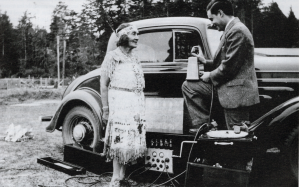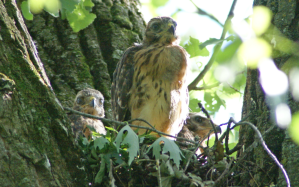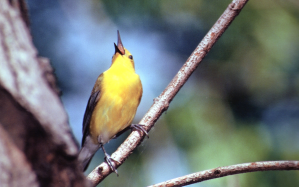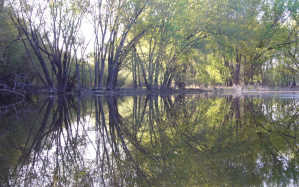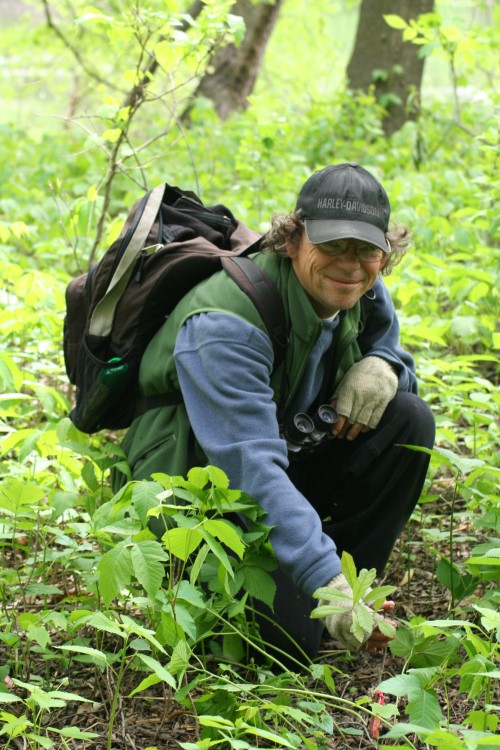A Field Season on the upper Mississippi River
(Copyright 2011 by Richie Swanson)

INTRODUCTION: FEBRUARY 7, 2007
The frozen Mississippi readied itself to thunder. A wailing whine rolled slowly from the direction of the Wisconsin bank, where cottonwoods 90-feet tall sometimes provided summer-nest habitat for North America’s most rapidly declining warbler, the cerulean. Now the ice-whine grew louder, rumbling across the state line into Minnesota. Now it twanged as though some ancient-giant logger-musician were playing an enormous saw-blade. Boom! Crack! The bank shook, and scores of birds disappeared from feeders, fleeing as if a hawk had swooped in. But the ice-sounds conveyed two crucial messages. They indicated the ice was safe to walk, and they told me virtually the same thing the sultry-meandering river 400-miles south had once told Nigger Jim, Huck Finn and Tom Sawyer. Be free. Explore the possibilities of your world. Polish your binoculars and pull down your cap low to shade the eye where the cataract had been removed last month. Print out another species account from Birds of North America Online—no, print out the accounts of all 269 species generally seen on the Upper Miss, also the 36 accidental species. And run your wax-cleaning tool through your hearing aid and go agaming—an Anishinaubae (or Ojibwa or Chippewa) word meaning “on the other side of the river.”
My partner Barbi and I walked across the ice to Aghaming Park and Preserve, 1010 acres of wild woods, sloughs and marshes owned by the city of Winona, Minnesota but located across the Mississippi in Buffalo County, Wisconsin. We checked a nest structure used by a red-shouldered hawk the previous year. While we looked for signs that a great-horned owl had usurped the site, I said, “I think I want to blog about the birds at Aghaming.” “Sounds right up your alley,” she said.
To experience and chronicle seasonal change in nature—new sprouts, birds, mammals, bugs in the floodplain—every new sight, sound, smell, taste and feel–had been of hankering of mine for decades. I hired a technician to create a template and birded Aghaming three-five days per week until July 4. I obsessed online, accessing scientific documents that frequently revealed insights to behaviors and conservation issues I witnessed in the field. I published posts every seven days or so, emailing experts across the continent and relying heavily about the knowledge of regional wildlife officials.
Viruses and other problems troubled the blog, so I moved it to www.WarblingRichie.com. The text remains virtually the same as it appeared in 2007. Photos from Barbi Bell, Kay Shaw, Kathy Bibby, Allen Blake Sheldon, Andy Nyhus, Bill Drazkowski and Howard Munson of the Hiawatha Valley Audubon Society have been added. If you’re interested in viewing more photos or purchasing them, you can link to Photographers on the bird study page. If you’re interested in subsequent events at Aghaming, you can click on Frozen River Walks, Passenger Pigeon Walks on the Bird Studies page–educational walks sponsored by Mississippi River Revival in Winona.
DIRECTIONS TO AGHAMING PARK AND PRESERVE
You might follow a cerulean warbler from an old-growth forest in the Andes Mountains, a prothonotary warbler from a mangrove swamp in Venezuela or Columbia, a yellow-crowned night heron from an inter-tidal zone on the Gulf of Mexico, or a wood duck or hooded merganser from the wooded swamps of the lower Mississippi River. These and many other species will bring you upriver to Winona, Minnesota.
From Winona drive east on Minnesota Highway 43 across the interstate bridge. Turn right onto Latsch Island before the Welcome-to-Wisconsin sign. Do not turn onto any dirt road. Continue right on paved road toward the main channel, the MN side, of river. Drive downriver beside channel 1/8 mile until the High Wagon Bridge appears on the left. Cross the bridge and meet at the Aghaming Park and Preserve Sign.
Though it remains unmarked, the old dike I call Prothonotary Trail starts just behind the sign, angling off toward the Wisconsin bluffs. It and the old cement road you park on (Cape May Boulevard, also unmarked) represent the tip of the iceberg of communing with nature at Aghaming.
TABLE OF CONTENTS
Granddaddy Oak, 2-16-2007
The Raucous One, 2-23-2007
Eagles and Otters, 3-3-2007
Heron Highway, 3-13-2007
Red-shouldered Hawk, 3-18-2007
Unknown but Disappearing, 3-25-2007
Ducks in Drizzle and Rain, 4-1-2007
Despite Wintry Winds, 4-8-2007
Drilling Sap, Dumping Eggs, 4-15-2007
Late April Shine, 4-22-2007
Virtuouso, Whip-poor-will, Prothonotary, 4-28-2007
Warblers In! 5-6-2007
Clock ticks for cuckoo, 5-13-2007
Warbler and Wren, 5-20-2007
Black Tern, Great Egret, 5-27-2007
Red-headed, Least Bittern, Red-shouldered! 6-03-2007
Singing, Learning, Charming, 6-10-2007
An excess during Solstice Week, 6-19-2007
No quirr, no queak, yet sapsuckers squeak, 6-26-2007
Warbler, Cowbird, Predators, 7-04-2007
Last look at Upper & Lower Miss Birds, 7-04-2007
GRANDDADDY OAK, 2-16-2007

The swamp white oak stands with the winter sun caressing his bark gently gold, a granddaddy tree on a forgotten backwater island on the upper Mississippi River. He stands nearly two centuries broad and bulbous, easily old enough to have been shadowed by flocks of passenger pigeons during the 1800s. The flocks may have contained millions, even billions, of birds, stretching a mile wide, taking hours to pass. They descended into oaks so densely they piled five and six-deep on one another’s backs, shrieking and fluttering so noisily other forest animals fled. They fed upon acorns, and today the old oak holds open his twisted-bulky limbs, but he catches no more passenger pigeons than I can grasp sunlight from his trunk.
This past month, frozen sloughs rumbled around the oak at night, booming beneath Gemini, and the limbs loomed as heavy-dark shadows near the heart of this park and preserve called Aghaming. Aghaming comprises about 1100 acres of woods, sloughs, islands and marshes owned by the city of Winona, Minnesota, but it’s located across a 90-year old wagon bridge in Buffalo County, Wisconsin. It’s in the middle of the Upper Miss Valley, which will host nearly 300 species of birds in the coming months. Hundreds of threatened birds will migrate or breed at Aghaming. At least eight bird species with state or federal protections use Aghaming–the bald eagle, peregrine falcon, osprey, Caspian and Forster’s terns, great egret, cerulean warbler, yellow-crowned night heron and red-shouldered hawk. A ninth, the yellow-crowned night heron, was last seen in a slough here 30 years ago.
In February, barred owls hoo-haw frantically, and great horned owls already glower down protectively from nests. Black-capped chickadees whistle long-lazy fee-bee-e-e-e-es, and they clasp bills and pass seeds male-to-female at a feeder across the channel. Cardinals sing from territorial perches, and a pair of bald eagles float in high-bonding circles above a nest tree. The season of regeneration has begun!
Swamp white oaks, however, struggle to reproduce on the Upper Miss. Floods have flowed higher and lasted longer since the river’s locks and dams were built in the 1930s. Water tables have risen on islands, and trees adaptable to wetter conditions out-compete the oaks.
At Aghaming, most oak seedlings grow on dikes high enough to escape floods. The granddaddy grows on lower ground, and when floods subside, the invasive shrub buckthorn leafs out and shades the forest floor, and oak seedlings cannot be found. Silver maples dominate the woods on surrounding islands. When fertile ground opens, the windblown keys of maple and ash probably reach the sunny-muddy ground before acorns. Cottonwood puffballs, buckthorn seeds carried by birds, and canary grass seeds probably also find the openings first. Oak and other saplings also die during prolonged floods.
As sloughs melt around the oak, hooded mergansers will appear, eyeing nest holes in old trees. As Aghaming’s marshes thaw, a yellow-headed blackbird colony more than 30-years-old may sing from cattails, and two bitterns who battle the diminishment of emergent marshes, the American and least, may lurk in bulrush. As treetops turn green, at least 25 warblers may use Aghaming, including the rapidly declining cerulean and a tiny yellow bird who nests deeply in a dark stump but glows about as brightly as the tropical sun, the prothonotary warbler. The red-shouldered hawk will cry ear-splitting screams in treetops, and the great egret will fish sloughs in graceful silence.
The last three species symbolize the challenges of many threatened birds on the Upper Miss. They breed almost exclusively in floodplain forests and succeed best in large undisturbed tracts, which Aghaming helps provide. I will bird these bottomlands freely this spring, looking for such species, describing behaviors, ecology and conservation issues. I will post a free account every week.
I especially await the red-headed woodpecker, which I last saw at Aghaming in 1998, not far from the granddaddy oak. The species covets acorns, storing them inside trunks, closing up cache-holes with wood splinters. Thirty years ago, red-headeds quirred and queaked commonly at riverside parks and boat landings, flying around dead elms and oak groves. They carried out chase scenes as persistently as royal guardsmen in a British comedy, heads flashing scarlet, wings pumping boldly black and white. Will a single migrant use Aghaming this spring? Will a pair nest? Breeding Bird Survey data suggests the species’ population has declined by half since 1966.
Nonetheless, I hold hope. In Anishinaubae “agaming” means “on the other side of the river,” yet one crosses a current deeper than water when he visits the old oak. The granddaddy can draw you out of the human world, holding his ancient silence in his girth and the grope of his branches. In my mind, at least, he waits with open arms, without stirring, for kin and cousins of passenger pigeons, the flood of wild wings coming upriver from the south.
SOURCES
Baraga, Frederic. 1992. A Dictionary of the Anishinaubaey Language. Minnesota Historical Society Press. St. Paul MN.
Drazkowski, Bill. Hiawatha Valley Audubon Society. Winona MN. (personal communication, yellow-crowned night heron.)
Eckert, Allan W. 1965. The Silent Sky, The Incredible Extinction of the Passenger Pigeon. Landfall Press. Dayton OH.
Kilham, Lawrence. 1983. Woodpeckers of Eastern North America. Dover Publications, Inc. New York.
Nilles, Myron A. A History of Wapasha’s Prairie. The Winona County Bicentennial Committee.
North American Breeding Bird Survey. www.pwrc.usgs.gov/BBS.
Upper Mississippi River Conservation Committee. Nelson, Eric; Swenson, Gary; Urich, Randy, eds. 2002. Upper Mississippi and Illinois River Floodplain Forests.
Urich, Randy, forester, U.S. Army Corps of Engineers, La Crescent MN. (personal communication, oak regeneration.)
U.S. Geological Survey. Delaney, Robert; Lubinski, Kenneth; Theiling, Charles, eds. 1999. Ecological Status and Trends of the Upper Mississippi River System 1998.
THE RAUCOUS ONE – 2-23-2007

The crow in the silver maple branch jabs its bill up and down like a mean old man pointing a finger in a rage. It barks and cackles and mocks and threatens. CAR-AR-ARGH! It dives down suddenly against another, and the two grapple and fall the length of the trunk, clawing, shouting, pecking, slapping wings. The bottom crow flies out from under, and four more crows chase it, and the raucous one lands in a cottonwood-top, hitching up its wing-shoulders, puffing up big beside a crow-partner, cawing bloody murder.
The crow declares its space here at Aghaming Park and Preserve in fine tradition. These Mississippi River bottoms belong to the public and wildlife thanks to a territorial skirmish almost 100 years ago. A grocer from Winona, Minnesota named John Latsch found himself in a sudden June rain while alone on the river on a Sunday. He dragged his canoe ashore on a farmer’s bank, flipped it over and crawled under. But the farmer approached with a double-barreled shotgun and ordered the trespasser back into the rain.
Latsch was a frugal teetotaler, a quiet bachelor. The next day, he instructed an agent to buy the farmer’s land. Latsch eventually paid more than two million dollars for 18,000 acres of bottomlands on the Upper Miss. Latsch deeded three state parks and a portion of a fourth to the public. He gave the city of Winona acreage that would become a lake park, golf course, campground, ball fields—and Aghaming, about 1100 acres.
The American crow roams through endangered habitat here, the floodplain forest. River-woods may look abundant enough in the Upper Miss valley, where forests comprise 22-25% of the floodplain. The abundance is an illusion. Scientists estimate the forest made up 50-70% of the Upper Miss floodplain before European settlement, and 40% of the forest has been destroyed since the 1890s. Bird habitat on the south end of the flyway has fared worse, losing 80% of bottomland hardwood forests in the Mississippi’s lower alluvial plain.
The remaining forest is crucial for birds of North, Central and South America. Neo-tropical migrants tallied 56 of 84 species found breeding in Upper Miss floodplain forests in a comprehensive 1995 study. They tallied 40 of 70 species breeding at Aghaming in 1998, and 30 of 150 species detected during a spring migration study in Upper Miss habitats in 1993. Aghaming supports 12 of 16 neo-tropical species designated as species of concern for Midwestern floodplain forests during breeding season: cerulean and prothonotary warblers, yellow-billed cuckoo, great-crested flycatcher, American redstart, chimney swift, northern oriole, indigo bunting, gray catbird, least flycatcher, warbling vireo, common yellowthroat.
Two crows laugh while I anticipate the influx. HAR-HA! They peer into a frozen ice-fishing hole in a slough. Nothing in there. Seven more crows caw and gather around a Rorshach inkblot on the ice, blue-gray streaks full of hundreds of frozen-dead gizzard shad suspended an inch or two beneath the surface.
The late-February morning smells of snow-crust evaporating, rising mistily. There’s a worn beaver trail on bare dirt and fresh wood chips around gnawed-down hackberry trees. A lone robin screes as if to shake the winter from its high-quaking notes. A triangle of downy woodpeckers drum from river birches, and two hairy woodpeckers rattle-call, wave rigid bills and squeak woick-a-woick, chasing each other friskily around a trunk.
At Aghaming, crow nests beg endless questions for the months ahead.
They’re scrawny-looking, made mostly of maple twigs, seen in treetops every few acres in the woods. A great-horned owl or Cooper’s hawk might use them. Raccoons might sleep on them. In some places in the U.S., crows breed with five-seven helpers who may or may not be yearlings. The helpers bring sticks to nests and let the mother bird arrange them. They bring food to incubating females and nestlings. In other places, no helpers exist. Crows almost always build new nests each spring. Where will the next nest be? What will happen in it?
A few Aprils ago, fifteen crows chased a barred owl suddenly across a slough. The owl landed on a oak branch against the trunk. The crows swooped into the tree. The owl swiveled around and glared, then bowed its head and blinked. The crows scolded, hopping closer. The owl fled again, and a red-shouldered hawk screamed, a state-endangered species. It shrieked through all the noise, flashing its rough-edged wings and rufous-rich breast, quickly gone. The cries were savage, ripping through foliage, exploding above water.
Eleven months later, a muted cry rose near the same oak, sounding like a distant red-shouldered, shy and seemingly out of character. The hawk called from a maple less than 50 yards away. A second red-shouldered flew in. He mounted her. They shuffled up and down. A crow leaned forward and watched from the next tree, slumping a little, silent instead of raucous. I could almost feel a gulp in the crow’s throat, really my gulp. Thank you, Mister Latsch!
And today? The raucous one laughs throatily in the cottonwood-top. Snowflakes fall. Twenty-nine inches are on their way.
SOURCES
Christenson, Jerome. 1998. Behind the Island—The Land, The People, The River. Aghaming Park: A Community Resource Plan. City of Winona, Minnesota.
Knutson, M.G., Klaas, E.E. 1998. Floodplain Forest Loss and Changes in Forest Community Composition and Structure in the Upper Mississippi River: A Wildlife Habitat at Risk. Natural Areas Journal 18: 138-150.
Knutson, M.G., Hoover, J.P., Klaas, E.E. 1998. The importance of floodplain forests in the conservation and management of neotropical migratory birds in the Midwest.
Management of Midwestern Landscapes for the Conservation of Neotroprical Migratory Birds. Forest Service–U.S. Department of Agriculture. St. Paul MN.
Schumacher, C. 1993. Point count monitoring of migratory birds on Pools 4-8 of the Upper Mississippi River National Wildlife and Fish Refuge. U.S. Fish and Wildlife Service, Upper Mississippi River National Wildlife and Fish Refuge, Winona MN.
Swanson, R. 1998. The Breeding Birds of Aghaming Park. Aghaming Park: A Community Resource Plan. City of Winona, Minnesota. The bird report can be accessed at www.WarblingRichie.com.
Verbeek, N.A.M., and C. Caffrey. 2002. American Crow (Corvus brachyrhynchos). In The Birds of North America, No. 647 (A. Poole and F. Gills, eds.) The Birds of North America, Inc., Philadelphia, PA.
EAGLES AND OTTERS, 3-3-2007
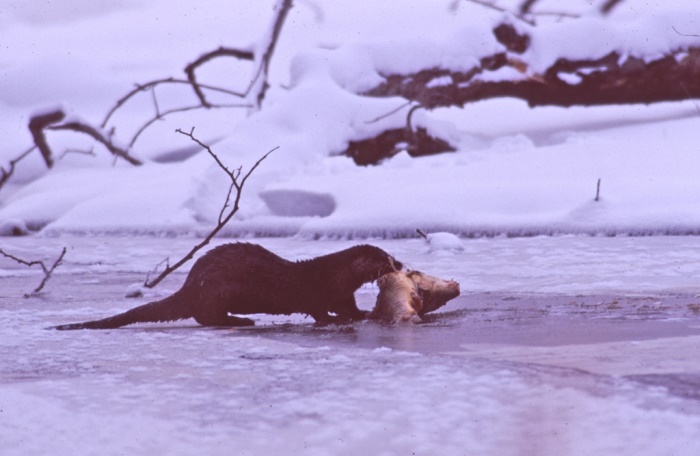
Two bald eagles swoop low above the Mississippi, mature birds with heads as white as the four feet of snow dumped on the river-ice this week. The eagles dip and rise, looping around each other, and suddenly one stands belly-deep in snow, its yellow glare imperturbable, its legs rigid as if a talon were squeezing a rabbit caught atop the river at dawn. But the eagle flies to a cottonwood and pecks a frozen slab of fish left by the dark-wiggling shapes that slid in moonlight last night—river otters!
The first otter loped in front of a bank at Aghaming Park and Preserve, moving as fluidly as a tubular water balloon slipping from your hands. Two more emerged from snow and rolled together, noses knocking, paws intertwined. They tobogganed on their bellies, and the first stretched its back against a snow-heap as if enjoying a scratch, and a red fox stepped up from behind, ears perked, snout pointing intently.
The head of a fourth otter shot up as it tread water hidden by snow. The otters were probably a family group, last year’s litter with their mother, who will not have new pups until April or May. One otter slunk rapidly toward the fox, and the fox approached in a stalk. The otter lunged, appearing to nip the fox’s paw, and the fox circled, and the other otters scurried off and then swung around and started back.
The fox and otters lunged and nipped at one another for about 15 minutes. The fox vanished. It reappeared limping, holding up a front paw. It lay in the snow-heap and rubbed its face, twisting and sliding itself along the snow like a housecat in heat. It snuck toward the otters again, and one charged, and the fox leapt up, dashed sideways and hunched down on its forepaws. The otters and fox chased one another about 20 more minutes in the dark, resembling dogs playing in a park.
This morning, crumbly-green scat full of fish scales marks the edges of a few small, fast-flowing holes in the river-snow. Otters use such holes to snap up sunfish, carp, suckers or other fish. They may den in an abandoned beaver lodge, woodchuck burrow or other hole, or beneath the many upturned root wads of Aghaming’s fallen trees.
Now an immature eagle stands above a fish-blood stain beside a hole, looking like an unkempt and oversized osprey, thanks to the black eye-line and whitish-brownish face of the bird’s third-year plumage. The mature eagle swoops down from its cottonwood immediately, displacing the younger bird from the scavenging site, chasing it over the tops of two islands and out of sight.
One-half mile downriver a mature “white-head” peers from a treetop at snow piled above the massive stick-rim of its nest, and I hope no eggs lay destroyed inside. A great-horned owl has been incubating a nearby nest since early February, but she’s nowhere today, and her nest is capped with snow too.
Eagles lay eggs on the Upper Miss as early as mid-February. Aghaming’s eagle nest declared itself loudly last March. I inadvertently walked beneath it, and the parent-birds wheeled uneasily up in the blue-dawn sky. Squeals descended everywhere at once, getting louder, longer, faster, higher-pitched every urgent moment. Kwit kwit kwit kwit kee-kee-kee-kee-ker! I moved on. Guidelines suggest people stay more than 400 yards away from eagle nests, so the birds don’t flush.
During courtship, usually February here, eagles lock talons high in the sky and cartwheel together nearly to the ground. Migrants currently soar along on thermals above the river bluffs. By April, ospreys and eagles dive-bomb one another and scream aggressively near fishing perches.
By the 20th century, bald eagles had declined dramatically through the contiguous 48 U.S. states. Well-known estimates derive from Chesapeake Bay: about 3,000 pairs at European settlement, 600 by 1936, 70 by 1965. In 1986, only nine nests were counted along the 260-mile stretch of the Upper Miss from Wabasha, Minnesota to Davenport, Iowa. But in 1996, the stretch had 62 nests; in 2006, 165!
Humans caused the decline of eagles in many ways: shooting and trapping to protect livestock and game; egg collection; lead poisoning from shot and bullets in prey and scavenged carcasses; loss of shoreline habitat and undisturbed nest sites; oil spills in coastal breeding areas; poisoning from heavy metals, pesticides and other contaminants.
After 1947, the use of DDT impaired the bald eagle’s breeding efforts. Eagles ingested the pesticide and its breakdown products in fatty tissues of fish, ducks and other prey. Birds laid eggs with shells so thin they broke before eaglets hatched. Nest failure was most closely linked to concentrations of DDT’s breakdown product DDE. Sometimes eagles failed to lay eggs, or eggs were sterile, or nests failed for undetermined reasons. DDT and DDE may also have caused birth defects and changes in parental behavior.
Bald eagle populations increased dramatically after the ban on DDT in 1972. As eagles rebound on the Upper Miss, river otters return to its tributaries. By the early 1900s, otters existed nowhere in Iowa but along and beside the Big Muddy. By 1989, Illinois estimated it had fewer than 100 otters, mostly living in the Big Muddy’s backwaters. Both states reintroduced otters from Louisiana and benefited from stronger water-quality standards and other environmental laws. Otters are now found in every county in Illinois and are reproducing in at least 75 of Iowa’s 99 counties.
Sometimes, wildlife populations roll like playful dark shapes in moonlit snow. They can seem suddenly gone. But when mankind allows them suitable conditions, they can pop up and be happily seen again.
SOURCES
Buehler, David A. 2004-5. Bald Eagle (Haliaeetus leucocephalus). In The Birds of North America, No. 506 (A. Poole and F. Gills, eds.) The Birds of North America, Inc., Philadelphia, PA.
Illinois Department of Resources. Illinois Furbearer Guide: River Otter. http://dnr.state.il.us/orc/wildlife/furbearers/river_otter.html.
Iowa Department of Natural Resources. River Otter Restoration. www.iowadnr.com/wildlife/pdfs/2001_river_otter.pdf.
National Eagle Center. The Human Effects on the Bald Eagle. www.nationaleaglecenter.org.
Nugent, Judy. February 2007. Spry Slider. Wisconsin Natural Resources magazine.
Upper Mississippi River National Wildlife & Fish Refuge. 2006. Bald Eagle Nesting on the Refuge. Bald Eagle Production (2006).
HERON HIGHWAY, 3-13-2007

The back channel of the Mississippi has been frozen since late December, but the evening air is 50 degrees, and the bald eagle doesn’t even glance at me as it glides a few feet past the rail of the Wagon Bridge. It stares seriously down at holes suddenly open around abutments. It circles back and forth, rising and dipping, and a talon skims water, clutching a walleye, and then a great blue heron scrawks overhead, my first heron sound this spring.
The channel opens wide the next morning, and a great-blue wades in front of a bank of dirt and snow. Another flutters its big-awkward wings and stabs the current with its bill as if it were an oversized tern. It takes a four-inch shad. Another great-blue fishes from a root-wad, and three fly toward backwaters.
I find the ice too soupy and mushy to cross in the backwaters. The ice smells like hundreds of dead shad thawing, like a catfish spoiling an inch from your nose. A sandhill crane croaks, ring-billed gulls yelp in the sky, and merganser-wings whistle, all “spring-firsts.”
A group of hole nesters stir in a little line of raggedy birches behind 30 yards of bulrush. A downy woodpecker slides his bill into water-on-ice, drinking, and a white-breasted nuthatch bows her way into a knothole. Two chickadees pop in and out of holes in a stump, and a red-bellied woodpecker flashes past a hole high in a trunk, shaking a piece of bark in its bill.
Red-bellieds don’t line nest holes with bark or leaf-matter. But this male taps softly and churs, and a female chucks repeatedly above him, and I hope she’ll fly down and approve his hole-selection by joining him in the species’ ritual of mutual tapping and excavation. But he flies off and forages.
Twenty species are cavity nesters in floodplain forests on the Upper Miss, including seven woodpeckers. The woodpeckers create holes for such neotropical migrants as the great-crested flycatcher, chimney swift, tree swallow and house wren. Eastern bluebirds, barred owls, wood ducks and hooded mergansers also nest in holes in trees at Aghaming Park and Preserve.
A brown creeper sings. He’s about the size of a house mouse, spiraling down a furrowed trunk with plumage mottled buff and brown, hard to see. Brown creepers use decurved bills to glean insect larvae, spider eggs and other food throughout winter at Aghaming. The male usually sings only on his breeding grounds, usually starting mid-March. His mate builds a nest between a trunk and loose piece of bark, using maple keys, shreds of grapevine-bark and other materials.
Great blue herons fly back and forth all day above the Mississippi. They presumably visit the old nests in a nearby breeding colony, one of 12-16 colonies that hold about 5,000 nests total on the Upper Miss. In the evening, eight great-blues stand on skinny-delicate legs on a rim of ice one-half mile up the open channel. Five or six more stalk along the edges of grass on an island’s banks, perhaps looking for rodents as well as fish. Several more stand on another ice-rim and island farther upriver.
The sky here gets so busy with great-blues we call it Heron Highway. We wait to see herons flying with sticks in bills. Males carry sticks to nests and guard them, so other males will not sneak them to their own tree. A male will also present a stick to a female, who then stretches her bill skyward, howls, takes the stick and places it on the nest while the male claps his bill.
Common mergansers, common goldeneye, Canada geese, mallards, a ring-necked duck, six wood ducks and three American black ducks also flew above Aghaming today. They’ve a tiny hint of waves to come. A whopping 40% of North America’s waterfowl migrate on the Mississippi River flyway.
Last night, a bald eagle flew up from an island with a wad of soggy grass in a talon. Two perched on opposite branches above their nest and peered in. One left the grass hanging from a branch, and this morning it was gone, presumably inside the nest. An adult eagle also dive-bombed and chased a juvenile high in the sky. The eagles continue to tend their nest, despite recent snowstorms.
A great horned owl nest remains empty, though a bird hunkered down on it from at least February 10 to 23, when the big snows started to fall.
SOURCES
Butler, Robert W. 1992. Great Blue Heron. In Birds of North America, No. 25. (A. Poole, P. Stettenheim, and F. Gill, eds.) Philadephia: The Academy of Sciences; Washington D.C.: The American Ornithologists Union.
Hejl, S.J., K.R. Newton, M.E. McFadzen, J.S. Young, and G.K. Ghalambor. 2002. Brown Creeper (Certhia Americana). In Birds of North America, No. 669. (A. Poole and F. Gill, eds.). The Birds of North America, Inc., Philadelphia PA.
Knutson, M.G., Hoover, J.P., Klass, E.E. 1998. The importance of floodplain forests in the conservation and management of neotropical migratory birds in the Midwest. Management of Midwestern Landscapes for the Conservation of Neotropical Migratory Birds. Forest Service—U.S. Department of Agriculture. St. Paul MN.
Sheckleford, C.E. R.E. Brown, and R.N. Conner. 2000. Red-bellied Woodpecker (Melanerpes carolinus). In The Birds of North America, No. 500 (A. Poole and F. Gill, eds.) The Birds of North America, Inc., Philadelphia PA.
Upper Mississippi River National Wildlife & Fish Refuge. Comprehensive Conservation Plan. 2006.
RED-SHOULDERED HAWK, 3-18-2007

This morning the loudest, most temperamental hawk on the river arrives silently, flying above a frozen slough. The red-shouldered hawk shows the creamy-rich rufous on its breast, belly and underwing coverts, and the narrow white bands on its dark tail, and then it vanishes above gray-branched maples. Wisconsin lists the red-shouldered hawk as legally threatened; Minnesota, as a species of special concern. Nests have been documented at Aghaming Park and Preserve since 1994. In the past, the red-shouldered has traded nest locations with great horned owls on alternate years. Last year, it appeared to avoid a bald eagle’s nest, breeding deep in woods away from vehicle traffic.
I first saw the red-shouldered at Aghaming in the 1980s, perched atop a snapped-off trunk, turning its head away as if insulted by my presence, shrieking Kee-er! Kee-er! KEE-ER! Its cries ripple loudly through their indignant pitch, always making me feel a trespasser. The red-shouldered might flee above a slough, screaming at crows or owls. It might fly shrieking directly at them. It may circle on stiff-beating wings above an island, or burst up from a bank with a frog or crayfish in a talon, or flap noisily through foliage, dashing through treetops. A look at the species is usually fleeting, definitely the hawk’s preference.
The red-shouldered symbolizes the value of Aghaming’s 1100 acres to wildlife. The species needs 300-500 acres of contiguous undisturbed woods to breed. It nests almost exclusively in mature floodplain forests bordered by upland woods, rare habitat in the Midwest, where fields and other human developments border most riverbanks. In some Midwestern states, the red-shouldered has declined by 90% since European settlement, losing up to 98% of its habitat. The red-shouldered declined during the DDT era when pesticides diminished peregrine falcons, bald eagles and other raptors. Scientists still know little of the contaminants’ impact on the red-shouldered. A crucial stronghold for the hawk—Upper Mississippi National Wildlife & Fish Refuge—borders Aghaming up and downriver. The refuge contains the largest reserves of bottomland forests in the Midwest.
As the hawk flies off, a hooded merganser swims through open water at the mouth of a slough. He flattens his crest and throws back his head, and his white hood opens wide. A female swims from behind a sweeper, and the male croaks low and throaty like a frog. His eyes shine brilliantly yellow. Uncanny white lines run finely toward his tail.
Hooded mergansers nest in tree cavities. They breed sparingly at Aghaming. In some places, they lay eggs in the cavities of other hooded mergansers, wood ducks, common goldeneyes and common mergansers, all of whom respond in kind. The Mississippi flyway is critical for hooded mergansers, supporting about 60% of the continental population during January, and 87% of the mid-continental population during migration.
Qweek-Qweek-Qweek-Qweek! A hairy woodpecker hitches himself excitedly up a cottonwood-top. He raises his wings above his back and flutter-claps. He wags his head stiffly and rapidly, pointing up his bill. He chases another male from branch after branch. He chases him above the woods in circles, rattle-calling, and a merlin flies into the cottonwood-top. Merlins usually eat birds smaller than hairy woodpeckers; nonetheless, a female hairy is locked-up frozen against the trunk, not daring to move. The merlin tucks its bill against its breast several minutes. It flies across a slough and then wings through trees with another small raptor.
A pair of Eastern bluebirds also shows up in the woods today. Tundra swans hoot overhead, only three or five. A pied-billed grebe and bufflehead swim in the main channel. An American coot trails a drooping, iced-over wing in the current, paddling upstream. A pair of Canada geese waddle across a frozen slough, and two mink bound along a bank with frosty white chin-spots and fur rippling icily, just out of water. Flocks of common mergansers, mallards, geese and ring-billed gulls fly into stiff north winds.
While its nest-tree sways in 30-mph gusts, a bald eagle sits low inside its stick structure, incubating or brooding. Two great horned owls perch in opposite sides of a tree near the nest vacated after recent snowstorms. One hoo-hoo-hoos as if the pair still claims the territory and may try again.
SOURCES
Crocoll, S.T. 1994. Red-shouldered Hawk (Buteo lineatus). The Birds of North America Online. Ithaca: Cornell Laboratory of Ornithology; Retrieved from The Birds of North America Online database.
Dugger, B.D., K.M. Dugger, and L.H. Frederickson. 1994. Hooded Merganser (Lophodytes cucullatus). In The Birds of North America, No. 98 (A.Poole and F. Gill, eds.). The Academy of Natural Sciences; Washington, D.C: The American Ornithologists’ Union.
Jackson, J.A., H.R. Oullet, and B.J.S. Jackson. 2002. Hairy Woodpecker (Pioides villosus). In The Birds of North America, No. 702 (A.Poole and F. Gill, eds.). The Birds of North America, Inc., Philadelphia, PA.
McKay, Kelly J. and Stravers, Jon. 2005. Report on Red-shouldered Hawk Inventories in 2005, Milan Bottoms, Pools 12 & 13 of the Upper Mississippi River, Cumulative for 1983-2005, Pools 3-22. U.S. Army Corps of Engineers Natural Resources Management Section, Rock Island District.
Swanson, Richie. January/February 2004. Red-shouldered Hawk. Bird Watcher’s Digest.
Warkentin, I.G., N.S. Sodhi, R.H.M. Espie, A.F. Poole, L.W. Oliphant, P.C. James, and I.G. Warkentin. 2005. Merlin (Falco columbarius). The Birds of North America Online. (A. Poole, Ed.) Ithaca: Cornell Laboratory of Ornithology; Retrieved from The Birds of North America Online database.
UNKNOWN BUT DISAPPEARING, 3-25-2007
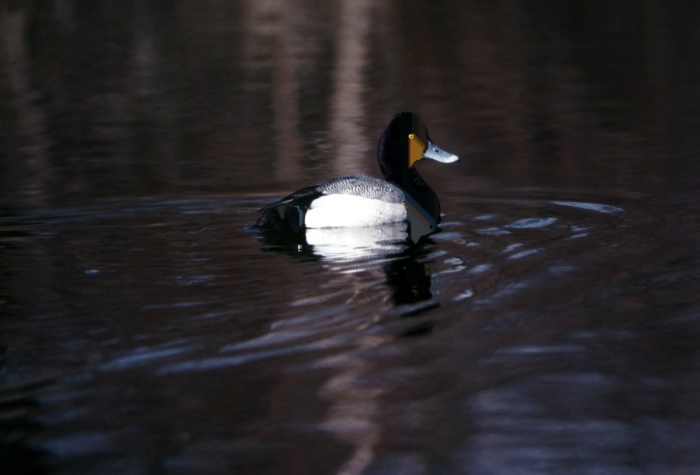
The rusty blackbird steps as nimbly as a tightrope artist across a wiry branch, then struts with purpose along a log floating in a half-thawed slough in the backwaters. He drags up a piece of bark longer than he is tall and pecks its underside. He tosses it away and hurriedly pulls apart a tangle of last year’s snakeweed. He eats caddis fly larvae, other aquatic insects and seeds. Frequently misidentified as the Brewer’s blackbird, the rusty has gone so unnoticed Gordon Orians barely mentioned the species in his excellent Blackbirds of the Americas in 1985. Recently, Audubon Society called the rusty blackbird North America’s most sharply declining bird species, due to a 95% decline since 1966.
A dozen rusties wade the shallow slough, searching with yellow eyes. A male wades belly-deep, wing-flicking water over his back, bathing. He suns himself on an overhanging branch of maple flowers blooming red—his plumage shining with a faint-green gloss, not purplish like the Brewer’s. A slate-gray female slurps a brownish worm, her yellow eyes conspicuous too. Both sexes sing a “squeaky koo-a-lee,” sounding like a red-winged blackbird’s song-phrase stopped abruptly in the middle.
The Upper Miss backwaters at Aghaming Park and Preserve typify the rusty’s stopover habitat. It feeds in wooded wetlands throughout the year. Scientists puzzle over causes of its decline. Winter populations concentrate in the lower Mississippi River valley, mostly deforested since European settlement. Migration also depends on bottomland forest, also mostly gone in the Upper Midwest. The species breeds in boreal forest wetlands where global warming appears to change water chemistry, water levels and insect populations. The rusty’s nearly absent from some boreal forests in Alberta, Saskatchewan, Northwest Territories and Ontario where it once was common.
Acid rain may reduce nutritional resources in the rusty’s boreal wetlands. Rusties may accumulate unhealthy levels of mercury from insect and small-fish prey. Blackbird control programs in the 1960s and 1970s, logging and peat production, and disease from other blackbirds may also have diminished the species. The Migratory Bird Center’s website lists ways to help, including submitting sightings.
As creeping Charlie sprouts from the brown-leafed earth here, birds headed north get restless. A hermit thrush perches on a log of fresh green moss, cocking its cinnamon-red tail upward, and it darts through air, snatching a bug against a sapling. A dark-eyed junco spots a dot of a bug from a branch and sorties after it like a flycatcher. Juncos have hissed at and chased other songbirds for weeks, constantly singing a dry trill. But the American tree sparrow lets go his sliding, musical tsi tsi tswee just this morning.
At Osprey Marsh at Aghaming, scores of juncos and tree sparrows feed in old-matted vegetation with newly arrived song sparrows. Redwings suddenly sing around the entire marsh. Konk-la-leee-eee-ee! Wood frogs slowly clack. A pair of gadwalls, blue-winged teals and mallards dabble in open pools. A muskrat slips onto ice, shoving soggy weed-stalks two-pawed into its mouth. Two geese stand on a nest-hump. American woodcock and common snipe flush from the ground, and a winter wren flits low between trees. A fox sparrow flashes its rufous tail above buttonbush still standing in snow. Wood ducks cry at every bend in every slough, flushing in flocks of five and six or as pairs high in limbs, where they likely eye nest holes.
Three double-crested cormorants perch in fog on a snag. Tundra swans hoot constantly overhead. Two formations of four white pelicans circle loftily in the sky, then float gracefully together.
The three species have experienced different population changes on the Upper Mississippi National Wildlife & Fish Refuge. Up to 90,000 double-crested cormorants used the refuge during the 1940s–but only 5,000 during a recent autumn. Tundra swans started feeding on the refuge in the mid-1980s. Now 20% of the eastern continental population migrate on the refuge each year, moving much more swiftly in spring than fall. More than 40,000 used pools 7 and 8 (Trempealeau to Genoa, Wisconsin) on a single day late last November–replenishing fat stores only on a small part of the refuge. A handful of white pelicans appeared in the early 1980s. More than 3,000 used it last year, though the nearest breeding colony occurs in western Minnesota.
Snow geese pass overhead, and an eastern phoebe sings its raspy name above the Wagon Bridge at Aghaming. Fee-bee! Even before laying eggs, females roost on nest-cups beneath man-made structures, probably using nests as insulators during cold nights, a pre-laying adaptation possibly unique to the species.
March 22, a great-horned owl sat in a nest that had been disrupted by late winter snowstorms, as if reoccupying it. I saw no owl on it the next two days, though soft hoo-hoos floated through trees around it.
SOURCES
Avery, M.L. 1995. Rusty Blackbird (Euphagus carolinus). In the Birds of North America, No. 200 (A Poole and F. Gill, eds.) The Academy of Natural Sciences, Philadelphia, and the American Ornithologists’ Union, Washington D.C.
http://nationalzoo.si.edu/ConservationAndScience/MigratoryBirds/Research/Rusty_Blackbird/decline.cfm. (Submit rusty blackbird sightings here.)
National Geographic Society. 1987. Field Guide to the Birds of North America. Second Edition. Washington D.C.
Orians, Gordon H. Blackbirds of the Americas. 1985. University of Washington Press. Seattle and London.
Upper Mississippi National Wildlife & Fish Refuge. 2006. Comprehensive Conservation Plan.
Weeks, Harmon P., Jr. 1994. Pre-laying nest roosting in the Eastern Phoebe: an energy-saving behavior? Journal of Field Ornithology 65: 52-57.
.
DUCKS IN DRIZZLE AND RAIN, 4-01-2007
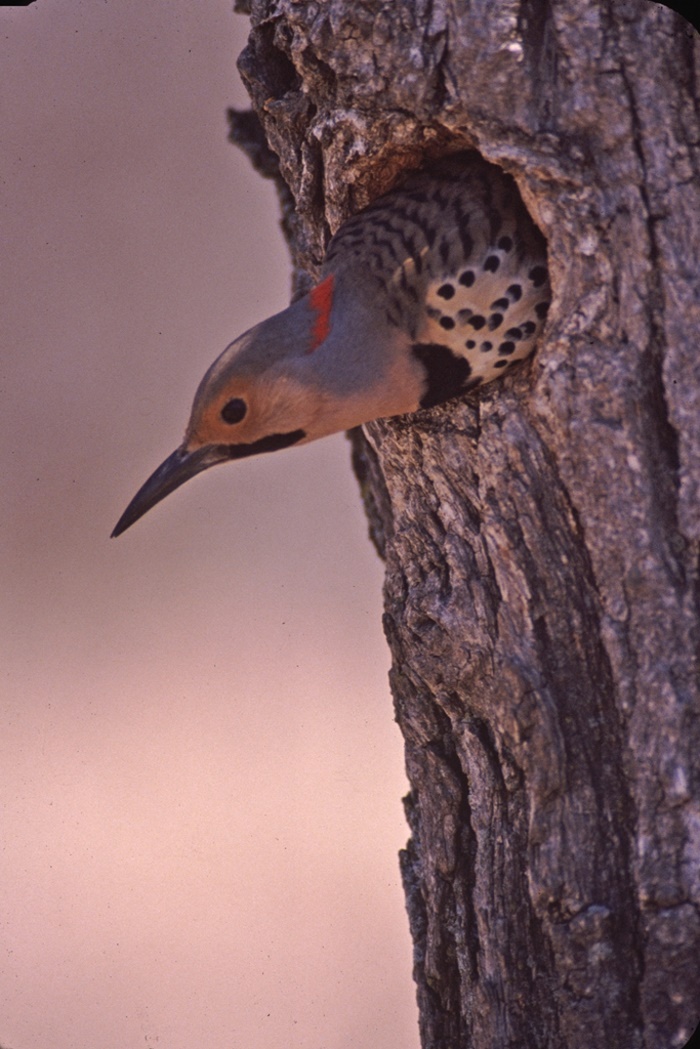
Though he’s the smallest duck on the river, the 20-ounce bufflehead guards his mate as aggressively as a 12-pound goose. Another male swims through the tight-knit flock, coming close, and the first lowers his bill and charges him, and the intruder spins away, and the first male sits up in a flurry of splashes, fluttering black-and-white. The white patches on his face swell suddenly into perfect-looking circles. He pumps his head again and again, flinging it vigorously backward, and then a northern flicker whoops high-rising cries. Kick!Kick!Kick!Kick!Kick!Kick! The woodpecker atop the big, old, river birch and the buffleheads diving in water to eat insects seem unrelated. But the duck depends upon the “yellow-hammer” to reproduce.
The bufflehead will soon leave the Upper Miss and Aghaming Park and Preserve, breeding primarily in poplars and aspens near ponds and lakes in Canada and Alaska. The species nests in cavities excavated by northern flickers so consistently scientists believe the bufflehead’s smallness might have evolved along with its nest-hole choice. No other duck fits regularly into flicker holes.
Northern flickers declined 52%, 1966-1991. The Midwestern species, the yellow-shafted flicker, continues to diminish by three percent per year, perhaps due to losses of snags, dead limbs and diseased trees from modern landscapes, or from cavities usurped by European starlings. Flicker migration peaks here early April, concentrating in river valleys. They’ll seem abundant in parks and wooded fields, crying wicka-wicka-wicka low on trees, foraging for ants.
This morning Osprey Marsh is finally ice-free, and a pair of scaup float out in open water, the white-flanked male with a purple-black head, the brownish female with a white patch near her bill. The species has declined precipitously since the 1980s. Their population loses about 150,000 per year. Females appear to arrive on breeding grounds (prairie potholes and western boreal forests to Alaska) with low fat reserves, possibly unable to produce full clutches of eggs. Low fat reserves may also cause females to die during migration, fail to reach breeding grounds, or not breed at all. Scientists believe food sources—especially freshwater shrimp, scuds—have declined on spring stopover sites throughout the Upper Midwest. Pool 19 of the Mississippi (Burlington to Keokuk, Iowa) provides scaup abundant foraging during spring, but like tundra swans on pools 7-8 during fall, too much of the continental population may feed at one location. Degradation of breeding habitat and contaminants may also contribute to the lesser scaup’s decline.
Cottonwood buds are out, and cedar waxwings peck around them. The river rises over islands, and rusty blackbirds swarm water sweeping bases of trees. One-hundred fifty screech through maple-tops with hundreds of redwings. Another 300 rusties swarm an island-tip, pecking around quickly-flowing puddles. About 600 rush around the bottomlands today. RiverBirdBlog’s previous post describes the rusty’s decline.
Eastern phoebes flood the woods, rasping their names every 100 yards. One sings intensely at a historic nest site. Fee-beee! He hovers and descends beneath an old bridge, crouching in midair, fluttering. A second flies in, and he chips wildly. A nest-site selection display! He hovers his way up a sapling. They fly off.
Two more phoebes descend from a spray of branches that dangle down into a primal soup of pale green duckweed, fallen-red maple flowers and dead leaves. Their bills skim the slough. Another phoebe flies in and out of a hole in a root wad. Available nest sites probably regulates the density of phoebes. If a male parent dies during nesting, a new male kills the young before mating with the remaining female.
Lilies, nettles, bedstraw and violets sprout beneath a cold gray rain. The sun shines momentarily, brightening a brown creeper on a trunk of lichen suddenly a soft-powdery green. A ruby-crowned kinglet darts around a treetop. A belted kingfisher rattles. A swamp sparrow rummages through slash. Wigeons squeak in marshes, and a pied-bill grebe cuck-a-cuck-cows.
A wood duck sneaks by, widening red-blazing eyes. Blue-winged teals swim past with moon-crescents on faces. Green-winged teals show glinting green masks above chestnut cheeks. Northern shovelers swim heavily, leaning strangely forward, straining food such as water fleas, midge larvae and seeds with long and clunky-looking bills. A horned grebe flushes, and a female hooded merganser turns, floating, and her brown plumage disappears completely against muddy water.
A great egret sails on crimped wings into a slough, a threatened species in Wisconsin, another bird requiring a floodplain forest to breed. A red cottonwood catkin lay swollen on mud, spilling yellow pollen, perhaps growing someday into a tall tree supporting an egret’s nest.
As spring asserts herself, the owl’s nest apparently disrupted last month remains empty. I saw a great horned in it only once after snowstorms capped it. Aghaming’s bald eagle continues to sit in a nest.
SOURCES
Anteau, M.J., Ph.D. Research Wildlife Biologist. Northern Prairie Wildlife Research Center. Jamestown N.D. (e-mail communication).
Anteau, M.J., Afton A.D. July 2004. Nutrient Reserves of Lesser Scaup (Aythya Affinis) During Spring Migration in the Mississippi Flyway: A Test of the Spring Condition Hypothesis. The Auk.
DuBowy, P.J. 1996. Northern Shoveler (Anas clypeatra). In The Birds of North America, No. 217. (A. Poole and F. Gill, eds.) The Academy of Natural Sciences, Philadelphia, and The American Ornithologists’ Union, Washington, D.C.
Gauthier, G. 1993. Bufflehead (Bucephala albeola). In The Birds of North America, No. 67. (A. Poole and F. Gill, eds.) The Academy of Natural Sciences, Philadelphia, and The American Ornithologists’ Union, Washington, D.C.
http://dnr.wi.gov/org/land/er/factsheets/birds/Gregret.htm.
Moore, W.S. 1995. Northern Flicker (Colaptes auratus). In Birds of North America, No. 166 (A. Poole and F. Gill, eds.) The Academy of Natural Sciences, Philadelphia, and The American Ornithologists’ Union, Washington, D.C.
North American Breeding Bird Survey. www.pwrc.usgs.gov/BBS.
Weeks, H.P., Jr. (1994) Eastern Phoebe (Sayornis phoebe). The Birds of North America Online (A. Poole, Ed.). Ithaca: Cornell Laboratory of Ornithology; Retrieved from The Birds of North America Online database. BNA No. 94.
DESPITE WINTRY WINDS, 4-08-2007
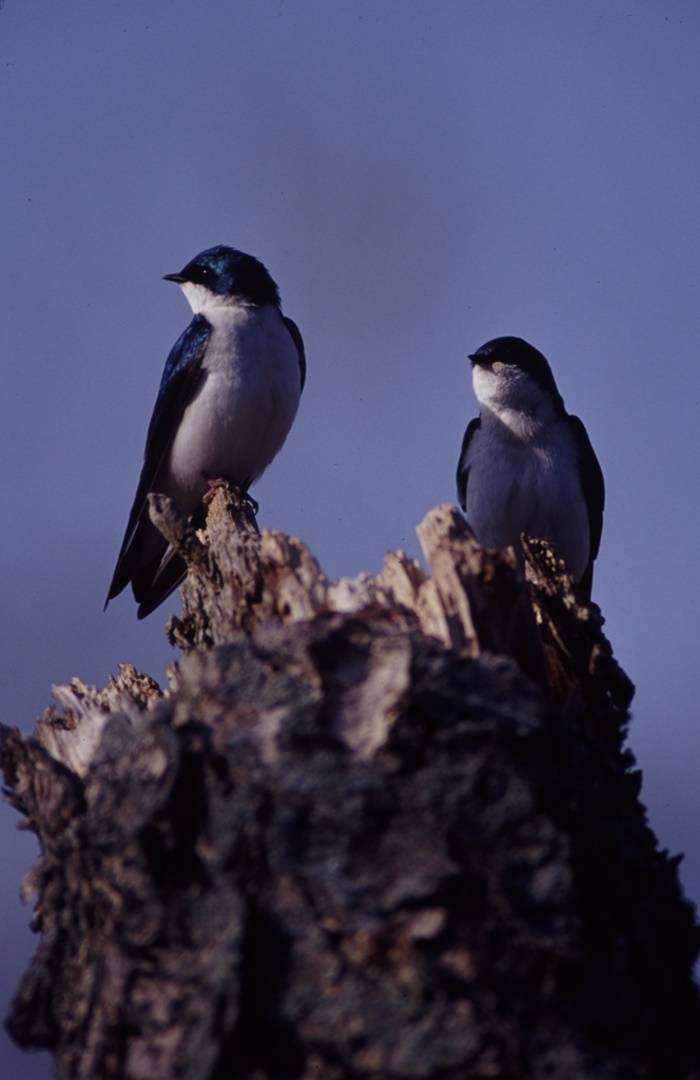
Wintry winds howl down the upper Mississippi, and tens of thousands of tree swallows cut through the sub-freezing blasts, wings as sharp as knives, a brighter-blue than the cold-sunny water, also iridescently green. The swallows skim whitecaps, beating bat-like strokes all across the front and back channels. Gusts blow them backward, and they right themselves and flap faster, keeping pace in an apparent race to nest holes in the Northwest Territories and other environs. Tree swallows hurry upriver probably from the Gulf of Mexico and Central America, and eventually some will kill others for nest holes, wrestling inside cavities, pecking backs and heads, driving intruders down into water to drown.
Scores will nest at Aghaming Park and Preserve. Besides other tree swallows, they battle wrens, sparrows, bluebirds, starlings, chickadees, flycatchers and flickers for holes. They favor river birches, gurgling an endless bubbling chatter, chitting, chew-chewing, peering down with immaculate white faces, their blue-green caps and capes looking as tight-fitting as spacesuits worn by Spock.
They arrive at dawn and defend holes by the time sun rises between the island-trees. They eat vegetable matter along with insects; put other species’ feathers in holes to claim them; place feathers in nests to curl atop eggs; can delay copulation and arrest egg-laying, waiting for warmth—all adaptations related to early migration.
The river ripples loudly across its forests’ floors, shoving ubiquitous red-rafts of maple flowers against logjams. I step around a flood pool, and a great blue heron scrawks beside my thigh, flushed from fishing behind a granddaddy oak. The year’s first warbler, the yellow-rumped, flits past a purple blackberry branch green with saw-toothed leaf-sprouts. This early migrant also feeds flexibly, gleaning insects from trunk-furrows, maple-flower rafts, leaves and branches. It eats barberries where available and can eat as many as 160 myrtle berries daily.
Water rushes through a cut, and an immense fallen cottonwood begins to float. Cedar waxwings gobble last year’s buckthorn and hawthorn berries. Blue jays squawk to each other and pipe bell-like tool-tools. A turkey vulture gnaws an opossum carcass up on the railroad dike. A state-threatened red-shouldered hawk cries. A male flicker climbs on a female in a treetop branch, and she depresses her tail, and a brown-headed cowbird squeaks his slow-heavy whistle overhead, just a single note, the call of a nest parasite once known as the buffalo bird.
A lone-male osprey cried from a nest platform Thursday, and today he and a female lean toward each other inside the mass of sticks. They step around each other, stretching and drooping wings, probably flirting. The male also hovers hundreds of feet high in the sky, chirp-scolding, descending talons-first toward a slow-circling bald eagle–eagles steal fish from osprey and displace them from nests. Suddenly two more eagles scream kr-r-rick, and the osprey chases them through treetops, and the first eagle circles higher, shooting splashes of whitewash against a peerless blue firmament.
Ospreys were once gunned to elimination in southeastern Minnesota. They declined worldwide during the DDT era, when eggshells grew too thin to bare the weight of incubating parents. The species remains state-threatened in Wisconsin. I saw no sign of it breeding at Aghaming until the summer of 1990, when an osprey placed a stick atop a power-pole crossbar in the middle of “Osprey” Marsh. The stick stayed balanced there until the next spring, when ospreys built a nest that seemed to grow bulkier and sturdier until winds in excess of 90 mph destroyed it in 1998. Ospreys now use a platform on a power pole beside the marsh.
Dawn broke at 17 degrees Saturday morning, and ice rings sparkled gold around stems of willow, red osier dogwood and other bushes at Osprey Marsh. Ice chunks lapped clinking against windward shores, and birds foraged at frozen flood pools in the lee of western banks. A song sparrow sprawled pinkish feet on ice, pecking amid frozen duckweed. A rusty blackbird—a rapidly declining species facing climate change on its northern breeding grounds and large losses of its winter and migratory habitats, bottomland woods—hammered its bill at grass beneath ice. A female rusty sat on her belly on ice and hammered, and a male came along with the species’ usual hasty gait, slipping a little, his back step sliding, his bill knocking at leaves and slash frozen beneath ice. A swamp sparrow walked back and forth beside a frozen birch log, pecking a thaw line glistening with sun and moisture, and a savannah sparrow sat still in high-blowing grasses, fluffing up feathers in gusts.
By noon today, three more vultures and several juvenile eagles floated above south-facing bluffs on the Wisconsin shore, and a sleek dark raptor plummeted a sudden-straight streak in front of an outcrop, striking the back of a mature eagle. A peregrine falcon, the fourth legally protected raptor encountered this morning. It has also rebounded on the upper Mississippi after the ban on DDT, thanks in part to reintroduction, another story for a future post.
Meanwhile diving ducks and dabblers continue to feed in sloughs and marshes. White pelicans soar in vees several-hundreds strong. Thousands of ring-billed gulls and a few herring gulls move through the flyway, and every spring breath tastes of coldness, mud, rising water and longer-lasting light.
SOURCES
http://dnr.wi.gov/org/land/er/factsheets/birds/Falcon.htm.
http://nationalzoo.si.edu/ConservationAndScience/MigratoryBirds/Research/Rusty_Blackbird/decline.cfm. (Submit rusty blackbird sightings here.)
Lowther, P.E. 1993. Brown-headed cowbird (Molothrus ater). In The Birds of North America, No. 47 (A. Poole and F. Gill, Eds.) Philadelphia: The Academy of Natural Sciences; Washington, D.C.: The American Ornithologists’ Union.
Pelikan, Mathew. June 1996. The Yellow-rumped clan. Birder’s World.
Poole, A.F., R.O. Bierregaard, and M.S. Martell. 2002. Osprey (Pandion haliaetus). In The Birds of North America, No. 683 (A. Poole and F. Gill, Eds). The Birds of North America, Inc., Philadelphia, PA.
Robertson, R.J., Stutchberry, B.J., and R.R. Cohen. 1992. Tree Swallow (Tachycineta bicolor). In Birds of North America, No. 11. (A.Poole, P. Stettenheim, and F. Gill, Eds.) Philadelphia: The Academy of Natural Sciences, Washington D.C.: The American Ornithologists’ Union.
DRILLING SAP, DUMPING EGGS, 4-15-2007
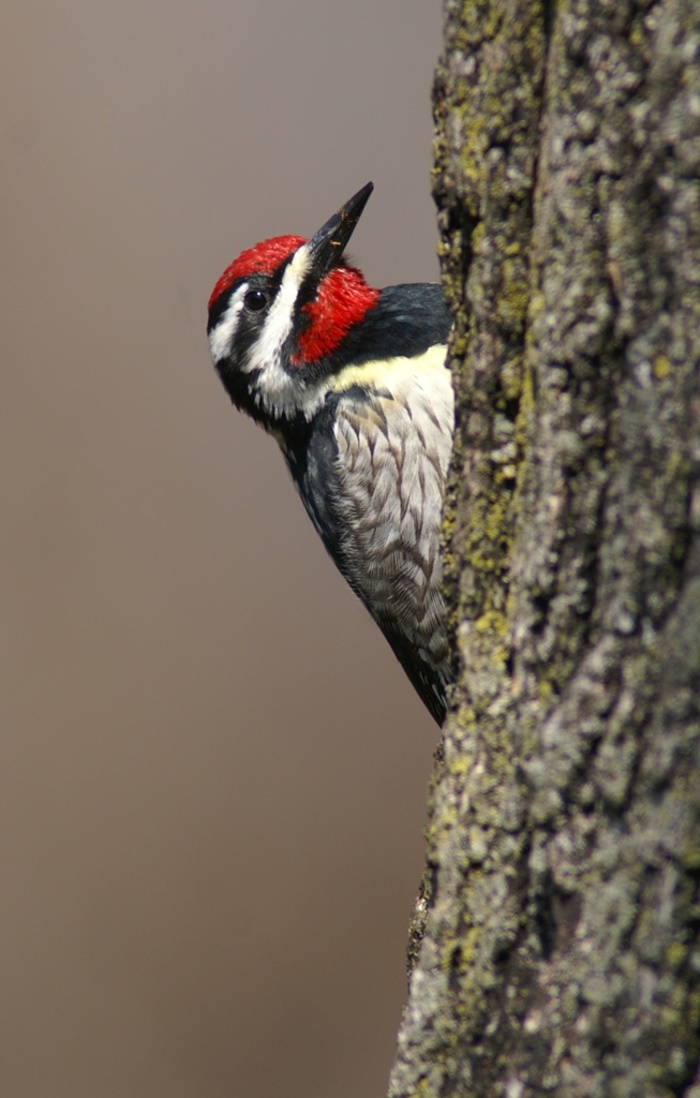
On Thursday, Wednesday’s snow falls splashing into flood pools, and a new drum unleashes itself in the woods. Ra-ta-ta-tatatatat! Tat-tat-tat-tat-tat-tat! A yellow-bellied sapsucker’s here from as far as Costa Rica or Panama, hugging a hackberry, quirking and squealing. Wee-tick! Wee-tick! Wee-tick! His throat and crest flame scarlet, and he hugs a trunk and glares at a second male on the trunk. They chase each around and up and down, thrusting wings half-open, threatening. Oh-wee! Oh-wee! Oh-wee! Oh-wee! They wave bills like pissed-off fingers. They fly with wings clapping into a cottonwood suddenly crowded with plump-dangling catkins. Oh-spring? Oh-spring? Oh-really finally-spring?
Willow and gooseberry leaves sprout. A fox barks to kits. Mallards’ eggs lay broken on the dirt, and a sapsucker hammers a little splinter of dead oak, making it sound enormous. A branch beneath him has scores of dots, last year’s chisel marks. A nearby hackberry has hundreds of such sap-well scars, row after horizontal row, and some birch branches seem to have 1,000. Yellow-bellied sapsuckers drill sap wells when leaves sprout, looking for high sugar content, licking sap with tongues, sometimes dipping ants into it before feeding young. Other woodpeckers and ruby-throated hummingbirds drink from sap wells—until the exuberant owner drives them off.
Now a female sapsucker drums right beside my ear, and a male swoops in. They vanish like lightning, but a female bluebird’s perched a little higher, maybe eyeing the ground for a beetle. A male lands, and their beaks meet, and he’s gone. She has a piece of grass in her bill. She flies to a hole in a dead oak branch and clings to the outside of it. She bows toward it. He slips out, and she slips in. The male has probably pulled off a successful nest demonstration, though she may try a few holes before she settles on one.
Three male cowbirds rattle in a cottonwood-top, lifting and spreading wings toward two females. The boys raise and fan their tails. They bow their heads and then hold them up in the sun, so their drab-brown hoods soften to a light coffee-color.
Brown-headed cowbirds lay their eggs in nests of at least 144 other species in North America, and because host birds feed cowbird nestlings more than their own, the cowbird has helped cause the near-extinction of Kirtland’s warblers and the serious declines of the wood thrush, ovenbird, prairie warbler and other songbirds.
Cowbirds can lay about 40 eggs per season in hosts’ nests, shove other bird’s eggs from nests and also eat the eggs for calcium. Before European settlement, cowbirds ranged only in open grasslands, feeding on bugs stirred up by buffalo herds. The species expanded with cleared forests, farm fields and suburbs to parasitize the nests of species “naïve” to their egg-dumping.
Cowbirds apparently lay eggs more often in nests of experienced song sparrows than first-time breeders, perhaps identifying the older birds by their aggressive behavior, a response to the cowbird’s threat.
As the Mississippi drops from its lowest crest in April in seven years, an Eastern phoebe carries mud and moss to the underside of a bridge now not-flooded. A female cowbird watches from the backside of a sapling, evidently sizing up a nest for an egg-dump before its cup is even half-formed.
A painted turtle suns itself on a log, and a lesser scaup lifts a blue-gray foot from Osprey Mash, spreading its webs, drifting in 55 degree sunshine–Ducks in drizzle and rain describe this species’ decline. A pair of redheads slurp weed stalks from beneath water—maybe coontail or a pondweed. The male has a rich chestnut head, a smoky blue bill, bright yellow eyes. The pair may have migrated up the Mississippi or west from the Atlantic and will breed in prairie potholes or the parkland or intermountain marshes beyond. A pair of northern pintails bask in front of bulrush, holding themselves with the most graceful-slender posture in the world, heading maybe to potholes too, but if they’re dry, as far away as a Siberian river delta. The hundreds of ring-necked ducks at Aghaming Park and Preserve will head beyond the realm of agriculture to boreal forests.
A barred owl squints in sun on a maple branch. Wood ducks stir and cry around the owl, and it blinks as if to go nowhere but an afternoon nap, and I follow suit.
SOURCES
Bellrose, F.C. 1976. Ducks, Geese and Swans of North America. Stackpole Books, Harrisburg, PA.
Gowaty, P.A., and J.H. Plissner. 1998. Eastern Bluebird (Sialis Sialis). In the Birds of North America, No. 381 (A. Poole and F. Gill, eds.). The Birds of North America, Inc., Philadelphia, PA.
Lowther, P.E. 1993. Brown-headed Cowbird (Moluthrus ater). In The Birds of North America, No. 47 (A. Poole and F. Gill, Eds.) Philadelphia: The Academy of Natural Sciences; Washington, D.C.: The American Ornitholgists’ Union.
Walters, E.L., E.H. Miller, and P.E. Lowther. 2002. Yellow-bellied sapsucker (Sphyrapius varius). In Birds of North America, No. 662 (A. Poole and F. Gill, eds.). The Birds of North America, Inc., Philadelphia PA.
www.borealbirds.org/birdguide/BD0402_species.shtml
www.mvp-wc.usace.army.mil
LATE APRIL SHINE, 4-22-2007
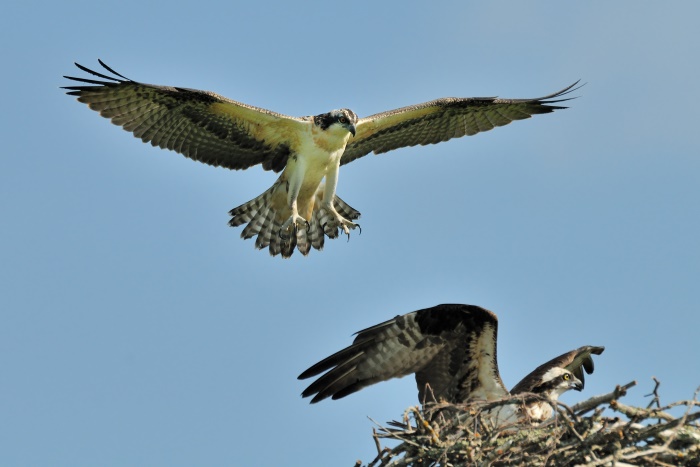
Miss Muddy Miss glistens, reflecting maples leafing out burgundy, box elders sprouting rusty and green, cottonwood-tops as soft and brushy as new willow shrubs. She still sparkles without dense-dark forest-shadows, flowing gold, blue, brown, green, red all at once, not hazed by heat or mosquitoes or midges yet, but buggy enough for the spring’s first uncommon migrant–a pine warbler. He forages in leaves shiny with sap, his breast as brightly yellow as tulip petals, and he might be bound to breed high in an old red or white pine at the Itasca headwaters, or in a jack pine farther north.
A few early songbirds shine…
A mousy bird—a kinglet—raises his ruby crown, twitters inside his throat, then belts out rushing-climbing tee-da-leets, shaking his sunny-olive wings with the haste of his notes. He’s bound for spruce-fir forests, where his song may facilitate neighbor recognition to other nesting ruby-crowns and save them aggressive interactions, including the species’ hyperactive, zigzagging flights.
A golden-crowned kinglet buzzes zree, and a palm warbler pumps a tail yellow on the underside, his rufous cap sharply contrasting waxy-yellow eye-stripes and a yellow throat. A rufous-sided towhee glints red in her eyes, curling purplish toes like grapevine tendrils around a branch, and yellow-rumped warblers feed around the chestnut-colored buds of a swamp white oak, a granddaddy who toppled crown-first into a slough last week.
A house wren flashes a cinnamon-toned tail barred black, spilling liquid phrases, and a northern waterthrush bobs at water’s edge, wagging a tail the same dark-dead brown as dead-wet leaves, black streaks dripping down a moist-yellow breast.
None of these species suffer serious declines. But the black duck—who flashes has been paired with a hen in Aghaming’s backwaters since mid-March—used the Mississippi Flyway in numbers that dropped 63% from 1955-1995. The species is intolerant of human disturbance, abandons eggs easily, still experiences egg-robbing by people and also suffers high rates of the duck plague and avian botulism. Much of its woodland nest habitat has been cleared around lakes, and much of its marsh habitat has been drained. Hunting took excessive harvests until a Humane Society lawsuit precipitated lower takes in 1983.
Dragonflies show up at Osprey Marsh, and so does a blackbird who eats them readily, the yellow-headed. He sings a nasal Kuk—koh—koh-koh—waaaaaaaaa that carries hundreds of yards even from deep-down inside a thick stand of cattails. The males arrive up to 14 days before females, wearing fine black eye-masks on solid yellow hoods. They establish territories for harems, and the number of females sometimes depends on the availability of dragonflies.
Yellow-heads have bred in the same location of cattails at Aghaming since at least the late 1970s. A male arches his head high, rising steeply, flapping choppy beats, showing off huge-white wing-spots. He lands above a redwing, fanning his tail, keeping it stiff and wide. He sings hoarsely down, and the redwing clings to his cattail-stalk, swells his red-orange epaulets, flicks his tail and cheents as if to attack.
A female redwing lands on a log lined with soft-shelled, snapping, Western and Eastern painted turtles. She pulls up a bleached-out weed stalk, perhaps making a nest her mate will fail to defend. Yellow-heads generally evict redwings, who are smaller, and whose dietary prey can overlap 90% with yellow-heads, mostly aquatic insects.
An osprey hovers, rises and shrieks in the sky, not chirp-calling as usual, but screeching. He screamed early Thursday, flapping rapid beats high above a back channel, and a female floated spread-winged through a blue hole in gray clouds with him. He hovered and screeched at two soaring eagles this morning and then shouted across Osprey Marsh with a minnow in a talon. He ended up on top of his mate on the rim of their nest, shuffling, flapping loosely, and after he got off, he half-opened his wings like a sunbathing cormorant, and she drooped hers. They stared off at the river bluffs and then into the nest, looking through black masks too, faces and bellies white. She pecked the fish he had probably brought her, and he flew a quick little loop and landed on her back again. Ospreys evidently copulate about 160 times per clutch, achieving cloacal contact about 59 times, usually producing three or four eggs.
Twelve ruddy ducks floated tightly together yesterday, hugging Prothonotary Trail. Powder-blue bills! Silly white cheek-patches! Cinnamon tails cocked zanily! They’re gone this morning, perhaps resting and feeding somewhere else after flying serious night-miles toward pothole regions in U.S. and Canada, where 86% of the species breeds.
SOURCES
Brua, R.B. 2001. Ruddy Duck (Oxyura jamaicensis). In The Birds of North America, No. 696 (A. Poole and F. Gill, eds.). The Birds of North America, Inc., Philadelphia PA.
http://audubon2.org/webapp/watchlist/viewSpecies.jsp?id=8
Longcore, J.R., D.G. McAuley, G.R. Hepp, and J.M. Rhymer. 2000. American Black Duck (Anas rubripes). In The Birds of North America, No. 481 (A. Poole and F. Gill, eds.). The Birds of North America, Inc., Philadelphia, PA.
Poole, A.F., R.O. Bierregaard, and M.S. Martell. 2002. Osprey (Pandion haliaetus). In The Birds of North America, No. 683 (A. Poole and F. Gill, eds.). The Birds of North America, Inc., Philadelphia, PA.
Twedt, D.J., and R.D. Crawford. 1995. Yellow-headed Blackbird (Xanthocephalus xanthocephalus). In The Birds of North America, No. 192 (A. Poole and F. Gill, eds.). The Academy of Natural Sciences, Philadelphia, and The American Ornithologists Union, Washington D.C.
VIRTUOUSO, WHIP-POOR-WILL, PROTHONOTARY!, 4-28-08
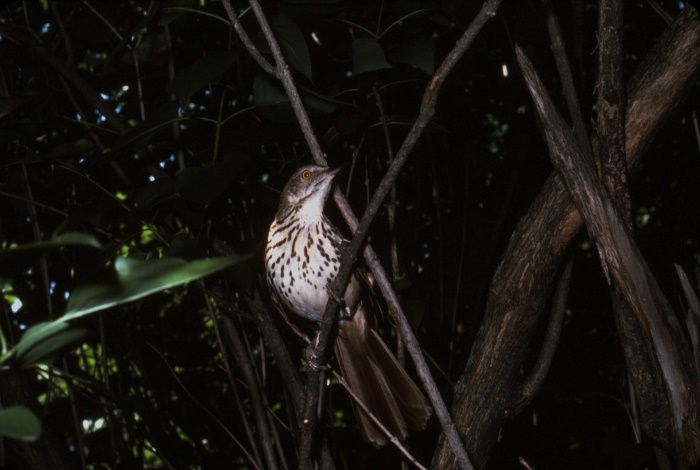
The brown thrasher perches atop a plum tree, sticks his tail down into blossoms, speeds up the robin’s song, rasps and slurs it. He flutes like the wood thrush, whits and pips, sings peter-peter like the titmouse, wit-cheers like the cardinal, hurries the redbird’s pretty-pretty, then jazzes it. Dawn-light creeps up his back, and he sings reedy vibrations into softly-muttered mews, catbird sounds. He makes crow-caws musical, pipes the pump-handle calls of the blue jay, wheedles the “jay” squawk and squeaks out a rusty-rising pitch, cackling like grackles. He flutes ethereal notes like a veery in a misty hollow. He sings witchity-witchity like the common yellowthroat due next week and cries the whip-poor-will of the declining species that called across the moony Mississippi Friday at dusk.
The brown thrasher can deliver 1,000 song phrases and 1,100 song types. He sings conspicuously only a short time during spring, until paired. Then he merely whispers his repertoire to his mate, keeping the nest, her presence and maybe even her fertile state secret inside a shrub.
The whip-poor-will, on the other hand, can call 1,000 times consecutively during nights while breeding. It can be heard throughout the year—but at diminishing locations. It eats moths and other insects from 30 minutes after sunset until the light allows, and it may time egg-hatching to full moons to optimize nocturnal foraging.
Whip-poor-wills have suffered local disappearances from Virginia to Texas to North Dakota to Michigan to Maine to Long Island. Wisconsin includes it in its Strategy for Wildlife Species of Greatest Conservation Need, due partly to its low abundance globally and deteriorating breeding conditions in sandy woodlands and other forests in the state. “The best thing birders can do right now for whip-poor-wills is probably to report their sightings to www.eBird.org/wi/ and participate in upcoming survey opportunities,” says Andy Paulios, Citizen Monitoring liaison, Wisconsin DNR. “We know so little of this bird.”
I hear it call only one night at Aghaming, no mornings. It apparently used the forest floor near shore as a brief stopover during migration.
Meanwhile other spring arrivals join ubiquitous yellow-rumped warblers in the bottomlands. Blue-gray gnatcatchers buzz around oak leaves sprouting the size of squirrel’s ears. A yellow warbler picks at a bank beneath a river birch just sprouting reddish buds and catkins. A rose-breasted grosbeak sings, and a winter wren forages beneath ash leaves freshly emerging above a slough.
A prothonotary warbler blazes gold in a new-green spray of leaves on a maple sweep, and a great crested flycatcher coughs a husky wheep from a cottonwood-crown suddenly shiny with full-sized foliage.
The prothonotary breeds only in bottomland forests, 90% gone in the U.S. The species has lost crucial winter habitat, 50-70% of mangrove swamps in Columbia and Ecuador. It declined 1.6% per year, 1966-1996. It
nests in a hole in a stump or tree no more than 16 feet from water, usually about six feet high. The male places moss in a hole, sometimes shapes it into a cup, and when a female approves, she finishes the nest.
A brown creeper rings out melodiously, swiftly. See-see-see-ti-ti-see! The five-inch creeper flies with three inches of hairy shreds crosswise in its bill. The mottled bird slips silently behind mottled bark ten feet up an old maple. It emerges again, creeps up a dead-bare trunk to the feeding hole of a downy woodpecker, scrapes mast, drops some, carries the rest back behind the loose bark.
A pileated woodpecker pokes half his face out of a hole 30 feet up a white-scarred river birch, revealing half of the red “moustache” the female lacks. He cocks his head sideways and peers up at six yellow-bellied sapsuckers clapping wings, squealing, chasing one another 20 feet higher in the birch. One sapsucker raps a splinter on top. The whole tree resonates. The pileated flinches, blinks, stares straight ahead as the sapsuckers fly off. He ultimately spits sawdust, excavating a nest cavity. He screams the shriek Hollywood used to play in jungle movies.
A male downy woodpecker flutters atop a female 40 feet high on an oak branch. She arches her head high, and he spreads all his white-and-black spots, fanning wings wide. His red nape-patch seems to rise and brighten. The pair slides sideway, twirling downward as if to fall, but he’s off her after ten seconds, their backs no longer exposed.
A Cooper’s hawk—predator of small birds–swoops onto a high branch, glaring sharply behind itself, scolding. Kak! Ak! Ak! Ak! It perches above a red-bellied woodpecker who seemed preoccupied a moment before, pecking a bark-scar, but now a barred owl soars low between trees, and the hawk dive-bombs it. The owl pulls up in a favorite maple, bowing its head beneath a thickly-curved trunk, gawking dumbly down at poison ivy pushing out new shiny leaves. The hawk glares on at the owl.
Leaves come out. The canopy closes. The woods fills with things that might get you, including mosquitoes. The “virtuoso” thrasher lets the sunrise brighten the reddish tones of his rufous plumage, raises his down-curved bill, sings yet another dawn chorus.
SOURCES
Bull, E.L., and J.E. Jackson. 1995. Pileated Woodpecker (Dryocopus pileatus). In The Birds of North America, No. 148 (A. Poole and F. Gill, eds.). The Academy of Natural Sciences, Philadelphia PA, and The American Ornithologists’ Union, Washington, D.C.
Cavitt, J.F., and C.A. Hass. 2000. Brown Thrasher (Toxostoma rufum). In The Birds of North America, No. 557 (A.Poole and F. Gill, eds.). The Birds of North America, Inc., Philadelphia, PA.
Cink, C.L. 2002. Whip-poor-will. (Caprimulgus vociferous). In the Birds of North America, No. 620 (A.Poole and F. Gill, eds.). The Birds of North America, Inc., Philadelphia, PA.
http://audubon2.org/webapp/watchlist/viewSpecies.jsp?id=165
Lanyon, W.E. 1997. Great Crested Flycatcher (Myiarchus crinitus). In The Birds of North America, No. 300 (A. Poole and F. Gill, eds.). The Academy of Natural Sciences, Philadelphia PA, and The American Ornithologists’ Union, Washington, D.C.
Petit, L.J. 1999. Prothonotary Warbler (Protonotaria citrea). In The Birds of North America, No. 408 (A. Poole and F. Gill, eds.). The Birds of North America, Inc., Philadelphia, PA.
WARBLERS IN!, 5-6-2007
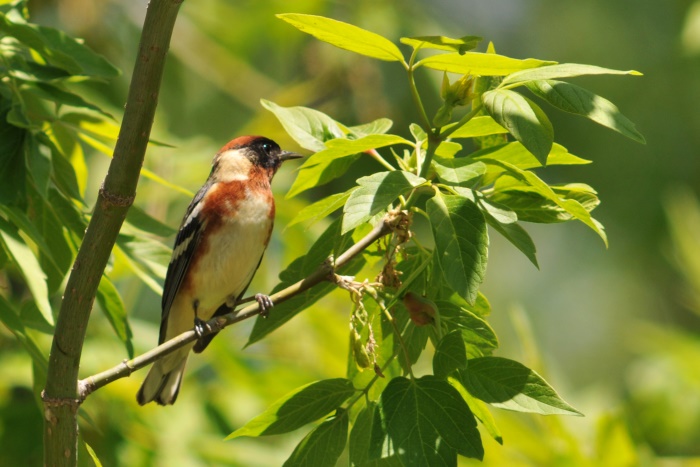
The south wind blows all day, gusting almost 40 mph, and the lazy-brown river suddenly rolls like surf, heaving backward, hurling spray up-channel. Leaves slap noisily on treetops, and birds from South and Central America dart around low in dense cover of exotic honeysuckles and buckthorn, foraging on leeward banks and dikes. Seventeen species that winter in mature forests in the tropics use Aghaming this weekend. Sixteen warblers use it, four considered conservation priorities by U.S. Fish & Wildlife Service, rare or declining. A Canada warbler spins on a branch, revealing a black necklace, and a prothonotary pokes its bill into a knothole, a possible nest site. A blue-winged forces his softly-sung beee-buzzzz into the wind-rattle, and a Cape May gleans bugs from river-birch catkins, flashing electric-chestnut ear-patches on yellow cheeks.
The prothonotary, Canada and Cape May symbolize challenges faced by many tropical migrants breeding in North America. They nest more successfully in large, unbroken forests than in smaller fragments, freer of predators and brown-headed cowbirds that penetrate edge-habitats. They require specific niches to reproduce. They shun disturbance, but their tropical woods are turning rapidly into pastures, cane fields and other peopled environs.
The prothonotary, of course, breeds only in mature floodplain forests. The Mississippi River Valley south of the Ohio River supports 20% of the species’ entire breeding population. The prothonotary breeds abundantly at Aghaming and suffers high rates of cowbird parasitism on the Upper Miss. Raccoons appeared to destroy 825 of 2726 nests studied in the Cache River Watershed, 1993-2000.
The Canada migrates from as far as northern Brazil and nests in dense-wet cover in boreal and northern hardwood forests in root wads, tree stumps, sphagnum-moss hummocks and rhododendron thickets. It has declined 40% since 1966. Rapid human growth and deforestation diminish its strongholds in the northern Andes.
The Cape May also breeds in boreal woods. Its populations swell during outbreaks of spruce budworms, an insect that defoliates fir and spruce in eastern U.S. and Canada. The Cape May nests high in thick crowns of conifers, probably needing trees older than most logging practices allow. It winters almost exclusively in the West Indies, thankfully using shade-coffee plantations, landing almost always in Florida as it migrates.
See the blue-winged warbler, see a little bird made of sunshine wearing wings spun from the noon-sky. The species’ nests in saplings and young trees at edges between forests and fields. Its breeding range expanded northward more than 100 years as North American forests were cleared, and abandoned farms turned into shrub habitat, and the climate warmed. Now older forests and urban sprawl usurp its habitat. The blue-winged hybridizes with—and replaces—the gold-winged warbler, another USFWS conservation priority, due at Aghaming any day.
Some tropical-forest species find food and refuge here temporarily, ultimately nesting farther north. A northern waterthrush tosses dead-drenched weeds from a floating log, bobbing so intensely the slough ripples beneath the “honeysuckle” dike. A gray-cheeked thrush skulks in leaf-litter—it breeds in dense shrubs in taiga and adjacent tundra from Newfoundland to eastern Siberia. A blue-headed vireo perches knee-level, a blackpoll gleans river-birch bark at eye-level, and Tennessee warblers trill fast-dry chips from tree crowns.
When the blackpoll returns from northeastern America, it may fly over the sea 88 consecutive hours, traveling 1500 to nearly 2200 miles to mainland South America. The species declined dramatically and inexplicably in some parts of its boreal breeding range 1980—2002: 54% in Alaska, 91% in British Columbia and Quebec, 78% in Newfoundland.
Other tropical-forest species will breed in the floodplain or nearby. A veery twirls on buttonbush above a slough, showing a smooth-tawny back, then the waxy-tawny wash on its speckled throat. An ovenbird kicks tiny-pink legs through dead foliage on the dike, jutting its russet-crown forward, pecking beneath new nettle-leaves, gulping. A black-and-white warbler zigzags eye-level on hackberry, then ash, oak and sassafras bark. It goes upside-down like the resident nuthatch and gleans insects with a decurved bill like the resident creeper. It’s only one of three of 241 neo-tropical migrants found in western Mexico that the ornithologist Richard Hutto classified as a habitat generalist.
An American redstart perches in sun head-high in honeysuckle, and a blue-gray gnatcatcher buzzes sharply, flicking a tail 45% of its body length, chasing a Cape May warbler from high in a walnut. The dearie-come-here of the yellow-throated vireo descends harshly and hoarsely from a granddaddy cottonwood.
Approach these woods from the Wagon Bridge, they may seem like the same local place. But birds from another continent’s forests have transformed them from ground-to-treetop since last week, filling them with darting-dashing-fluffing colors, with zee-zee-zoos, tseet-tseet-tseets, buzzes, carols, chips, with insect sorties, dive-bomb chases, leaf-litter hunts, tail-feather flashes, catkin-pecks, population problems.
Warbling vireos, chimney swifts, gray catbirds, green-backed herons, eastern kingbirds, indigo buntings, Least flycatchers, common yellowthroats and Wilson’s warblers also showed up at Aghaming this week.
SOURCES
Baltz, M.E., and S.C. Latta. 1998. Cape May Warbler (Dendroica tigrina). In The Birds of North America, No. 332 (A. Poole and F. Gill, eds.). The Birds of North America, Inc., Philadelphia, PA.
Conway, C.J. 1999. Canada Warbler (Wilsonia canadensis). In The Birds of North America, No. 421 (A. Poole and F. Gill, eds.). The Birds of North America, Inc., Philadelphia, PA.
Dobkin, David S., Ehrlich, Paul R., and Wheye, David. 1988. The Decline of Eastern Songbirds.
http://www.stanford.edu/group/standfordbirds/text/essays/Eastern_Songbirds.html
Gill, F.B., R.A. Canterbury, and J.L. Confer. 2001. Blue-winged Warbler (Vermivora pinus). In The Birds of North America, No. 584 (A. Poole and F. Gill, eds.). The Birds of North America, Inc., Philadelphia, PA.
Hoover, Jeffrey P. 2005. Water depth influences nest predation for a wetland-dependent bird in fragmented bottomland forests. Biological Conservation.
Kricher, John C. 1995. Black-and-white Warbler (Miniotilta varia)). In The Birds of North America, No. 158 (A. Poole and F. Gill, eds.). The Academy of Natural Sciences, Philadelphia, and The American Ornitholgists’ Union, Washington D.C.
http://audubon2.org/webap/watchlist/viewSpecies.jsp?id+165.
http://www.borealbirds.org/birdguide/bd0365_species.shtml
Swanson, R. 1998. The Breeding Birds of Aghaming Park. Aghaming Park: A Community Resource Plan. City of Winona, Minnesota. The bird report can be accessed at www.WarblingRichie.com.
U.S. Fish & Wildlife Service. January 2002. Fish and Wildlife Resource Conservation Priorities. Region 3. Version 2.0.
CLOCK TICKS FOR CUCKOO, 5-13-2007
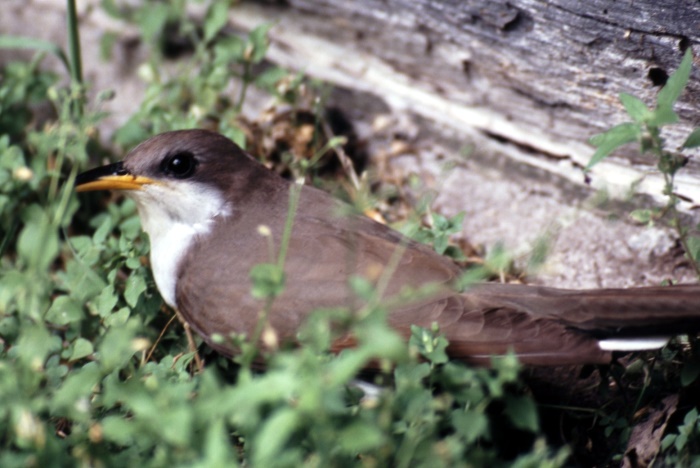
There’s dry-hollow knocks like an ancient-wooden clock, and then a yellow-billed cuckoo hides high in an oak, leaning, turning, and another flies up, and they blur behind leaves, and he bobs atop her, both slender like doves, grayish in cloudy light. The science says the male cuckoo reaches over the female’s shoulder, placing a twig in her bill, and the two hold it jointly until finished mating. But he hops off and dives down before I see any twig, and then she skulks forward, stares down after him and dives too, flashing rufous wings. Ka-ka-ka-ka-kow-kow-kow-kow-kowlp-kowlp-kowlp! The cuckoo utters a deliberate song vanishing swiftly from the Midwest, already gone from Oregon, Washington and British Columbia. The species declined 95% in Wisconsin 1966-1996 and continues to drop 2.5% per year in the upper Midwest, Region 3, USFWS.
During Migratory Bird Day weekend, May 11-14, 18 warblers use Aghaming, 11 which winter in mature tropical forests that are vanishing due to cattle ranching, soybeans, logging and subsistence agriculture. Nine other species from mature tropical forests also use these river-woods, including the cuckoo and scarlet tanager.
Though the yellow-billed cuckoo nests mostly in the eastern and central U.S., it winters as far south as Amazonia, and isolated populations may breed in South America. It may stagger migration and breeding dates to caterpillar outbreaks, nesting as late as September as far north as Ohio. It lays eggs in nests of other yellow-billeds and other species with similarly-colored shells. It can produce extra eggs during outbreaks of 17-year-locusts, tent caterpillars and gypsy moths. Its young fledge from nests only 17 days after egg-laying, thanks in part to feathers capable of flight a mere two hours after sheaths emerge.
Before the ban of DDT in 1972, spraying killed cuckoos outright. DDT apparently thinned eggs, and shells have not recovered their thickness yet. Tent-caterpillar control, other pesticides, may also have decreased cuckoos in some places. Many eastern and urban forests now lack the low-dense shrubs the species favors for nest sites. Cattle grazing, lower water tables, dams and inundations such as occur on the Colorado and Pecos Rivers destroy willow-cottonwood nest-sites out west. Only one percent of the species’ riparian-forest habitat in California remains. Though scientists and environmental alliances petitioned for the listing, the yellow-billed lacks Endangered Species Act protection.
Now a blazing-orange warbler lands beneath the cuckoo’s oak, the fluorescently-faced Blackburnian. It raises its flaming throat, sings crisply and clearly, zips to grapevine leaves, gleans the undersides. Blackburnians winter high in Andean forests as far south as Peru, sometimes Amazonia. They have vanished from breeding areas in the Appalachian Mountains where introduced aphids, wooly adelgids, have decimated Fraser firs and hemlocks. Blackburnians nest high in conifers, especially mature hemlocks, in spruce woods of Canda and the northeastern U.S. Like the Cape May and many other songbirds, it would benefit from longer logging rotations.
Suddenly a warbler-sized bill pokes from behind a cottonwood, followed by a yellow chin and the front of a black mask topped by a white streak. The bird flits up and hover-flutters with a black necklace and heavy black streaks aside a brilliant yellow breast–a magnolia warbler.
Another hops branch-to-branch in dogwood and tips down, white under its tail, its back darkly streaked like a blackpoll’s. It slaps a worm against a stem and spins, slurping its prey, showing a sunny-yellow cap, a reddish-brown vest, a black-splashed face. The chestnut-sided warbler sings, pulsating, Please, please, pleased to meetcha!
A common yellowthroat, black-masked like a tiny-stealthy bandit, rises from slough-water to slash, shakes and wags his tail, fluffs his wings. He sings repeatedly in sun-eking-through cloud, shining atop willow and birch. Witchity-witchity-witchity! He chases a female and then another male round and round through densely tangled stems and foliage.
A prothonotary warbler flies up as if its golden plumage passes magically through bark. As a crescent moon creeps up a navy-blue horizon the next morning, he tsit-tsit-tsit-tsits above a hole in a river-birch stump. He starts singing late, well after a house wren gushes liquid gurgles, the yellow-headed blackbird kuk-koh-koh-koh-waaaaaaaaas, and bulrush gains green tones on whitening water.
The prothonotary flicks his tail in a birch-crown, swells his throat, chips toothily, and two male redstarts flash orange-and-black behind him, pecking and falling through the day’s first sun-streaks. Later, a male and female American redstart forage quietly as if paired, but I haven’t seen a female prothonotary near this hole yet, nor any female yellow-headed blackbirds in the cattails.
The yellow-heads arrived three weeks ago. Are they bachelors? Floater-males at Osprey Marsh without any harem? Maybe by the time a black-throated green or cerulean warbler sing from a towering cottonwood, and osprey nestlings appear on their power pole, and the cuckoo settles on eggs, nature’s clock will tick off another answer.
SOURCES
Butler, Rhett A. January 9, 2006. Neotropical Realm: Environmental Profile. Mongabay.com/A Place out of Time: Tropical Rainforests and the Perils they face.
Dobkin, David S., Ehrlich, Paul R., and Wheye, David. 1988. The Decline of Eastern Songbirds. http://www.stanford.edu/group/standfordbirds/text/essays-/Eastern_Songbirds.html
Hughes, J.M. 1999. Yellow-billed Cuckoo (Coccyzus americanus). In The Birds of North America, No. 418 (A Poole and F. Gill, eds.) The Birds of North America, Inc., Philadelphia, PA.
Morse, D.H. 2004. Blackburnian Warbler (Dendroica fusca). The Birds of North American Online. (A. Poole, Ed.) Ithaca: Cornell Laboratory of Ornithology; Retrieved from The Birds of North America Online database.
Petit, Lisa. 1998. Fiery Gem. Blackburnian Warbler: Bird of the Month—Smithsonian Migratory Bird Center. http://nationalzoo.si.edu/printpage/default.cfm.
Suckling, Kieran. April 11, 2000. Yellow-billed cuckoo 60 day notice. Letter to Bruce Babbit, Secretary of Interior. http://www.biologicaldiversity.org/swcbd/species-/cuckoo/60day.html
WARBLER AND WREN, 5-20-2007
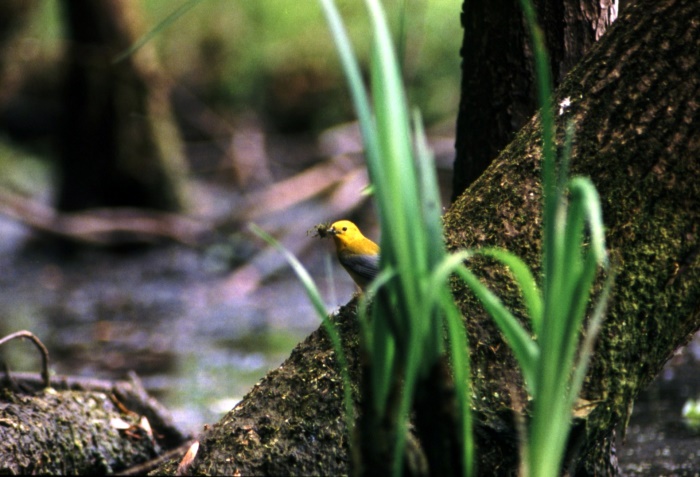
A luminous-yellow warbler-head pokes out a hole in a stump. Tiny black eyes glisten brilliantly in dark forest-shadow. The prothonotary warbler sings Cheet!-weet!-cheet!-cheet!-cheet!-wee! He ducks inside the hole, sings invisibly, pops out, flashes white tail patches, cranks up his cheet!-weet!-cheets! He goes in, and a female–a paler yellow–clings by toes to the hole’s rim. She tips her head in, and he pushes his face out between her tarsi, bird-ankles. She can’t squeeze past him, he can’t dart out. He sings beneath her belly, and both finally squirm down into the possible nest-site. The next morning a house wren pushes a four-inch twig across the two-inch hole, the stick bending, not fitting until he pokes it straight and drags it. Now his potential mate follows him in.
The wrens come out, wings quivering, and the male’s song gushes like a slender thread of river racing through a tiny crack. Luminous-yellow bullets streak at the wrens, chasing them through foliage, chipping loudly.
The male wren and prothonotary each attract females to cavities. The wren sings spontaneous song-types, varying syllables uniquely, bubbling out songs up to 600 times in an hour. He usually carries away any material found inside a hole, sometimes destroying other birds’ nests, also removing parasitic mites. He places ten to 400 twigs in a cavity, starting as many as seven nests, and the female will choose and finish one, making as many as 300 twig-trips per day.
A male prothonotary also sings near cavities, chasing other males as wrens and other birds do. He puts moss in cavities before females arrive, and after she’s here, he flutters above trees with head-up and tail open, then flutters down—singing, you know. The female builds the nest, using more moss than any other cavity-nester, perhaps to maintain a stable temperature for eggs and hatchlings.
The prothonotary nests only in a hole in a mature floodplain forest above or near water. The species has been losing habitat ever since steamboats started to churn up the Mississippi, and early visitors cleared trees for wood-hungry boilers. Only ten percent of prothonotary-habitat remains.
The house wren’s breeding opportunities have probably increased ever since fields and houses started replacing forests. The species nests many places, including farmyards, city parks, suburbs, forest-edges, open woods, coastal swamps, coniferous clear-cuts–even in cattle skulls, boots and fishing keels hung from walls. People provide the house wren nesting boxes from shopping malls, websites, craft fairs–literally thousands of convenient locations.
The wren pecks or removes eggs and offspring of other species from cavities. The wren may also kill adult cavity-nesters. Its impact on other species remains inadequately studied, but scientists have implicated the wren’s cavity-takeovers and destructions of eggs and nestlings as a primary source of nesting failure for tree swallows, chickadees, bluebirds—and the prothonotary warbler.
David Flaspohler found house wrens the most abundant species at prothonotary study-sites on the Mississippi and Black Rivers in Wisconsin, 1993-1994. Wrens were observed destroying only one of 42 prothonotary-nests; however missing eggs and disturbed nest-linings caused Flaspohler to suspect wrens played a larger role in nest failure, as found in previous studies.
Prothonotary-nests fail other ways. June flooding in 1993 destroyed eight of 22 nests during Flaspohler’s study. Raccoons appeared to destroy 825 of 2726 prothonotary-nests studied in the Cache River Watershed, 1993-2000. Red and gray squirrels, mink and blue jays are also likely predators at Aghaming.
Shortly after the two prothonotaries squirmed inside their short-lived hole, a female popped out a second hole and then looked into a third. Another female dive-bombed her, and the two zoomed down to dead maple roots. They glared at each other, pecking moss-hairs, then burst through the under-story in a golden flurry with a singing male. A female cowbird flew immediately into a low buttonbush beside the roots, turning her head toward all three holes, perhaps eyeing potential sites to deposit her eggs.
Cowbirds parasitized cavities at Flaspohler’s nest-sites at the highest rates reported in any prothonotary study, 26.9%. Cowbirds rarely lay eggs in house wren’s nest or cause them to neglect young by feeding cowbird chicks. Just four of 2,861 house-wrens nests were parasitized in a Canadian study.
You may want to forego wren boxes, as some wildlife managers suggest. Cowbirds and raccoons have–like house wrens–favored landscape changes made since Euro-American settlement. And the prothonotary and other warblers may be declining faster than scientific resources can detect. Ten years ago, 22 warbler-species used Aghaming on May 18, 20 in a single hour after a rainstorm. This May 18, I spent six hours finding eight species.
I make an insignificant comparison—certainly. And still, 20 warbler-species have used Aghaming since mid-April. Yet warblers seem sparse in treetops, and the rapidly declining cerulean warbler has not yet sung from historic breeding sites here this year.
Immense, old-growth, bottomland forests in the Mississippi Alluvial Valley (the river valley south of the Ohio River) once supported abundant cerulean warblers. They also supported the Bachman’s warbler, now probably extinct. The remnants of those woods still support 20% of the world’s prothonotary warblers. They exemplify crucial habitats nearly gone from the river—and Earth.
SOURCES
Flaspohler, D.J. 1996. Nesting Success of the Prothonotary Warbler in the Upper Mississippi River Bottomlands. Wilson Bulletin 108: 457-466.
Hamel, P.B. 1995. Bachman’s Warbler (Vermivora bachmani). In The Birds of North America, No. 150 (A. Poole and F. Gill, eds.). The Academy of Natural Sciences, Philadelphia PA, and the American Ornithologists’ Union, Washington, D.C.
Hamel, P.B. 2000. Cerulean Warbler (Dendroica cerulean). In The Birds of North America, No. 511 (A. Poole and F. Gill, eds.). The Birds of North America, Inc., Philadelphia, PA.
Hoover, Jeffrey P. 2005. Water depth influences nest predation for a wetland-dependent bird in fragmented bottomland forests. Biological Conservation.
Johnson, L.S. 1998. House Wren (Troglodytes aedon). In The Birds of North America, No. 380 (A. Poole and F. Gill, eds.). The Birds of North America, Inc., Philadelphia, PA.
Petit, Lisa J. 1999. Prothonotary Warbler (Protonoria citrea). In The Birds of North America, No. 408 (A. Poole and F. Gill, eds.). The Birds of North America, Inc., Philadelphia, PA.
Stokes, Donald W. 1979. A Guide to Bird Behavior, Volume 1. Little, Brown and Company, Boston, Toronto.
BLACK TERN, GREAT EGRET, 5-27-2007
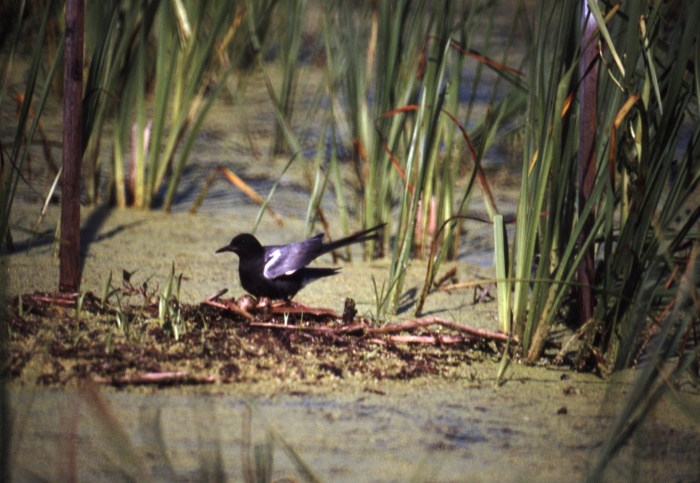
Kik! cries a black tern, dangling a fish from his bill, his wings as densely dark as a massing thunderhead, edged a grayish stratus-white on front. He flies from a remote slough at Aghaming toward a marsh at Trempealeau National Wildlife Refuge, once called the species’ most important breeding area on the Upper Miss. Will he land on a muskrat house, a potential nest site? Feed a female in display? He vanishes, but a second plummets suddenly-crookedly as if after a minnow, then veers jerkily with four others, their wings knifing higher than the river-bluffs, performing early courtship flights. Black terns declined 84.8% in the U.S., 1966-1989, 4.6 % per year on the Mississippi Flyway, 1966-2003. Winter flocks have decreased precipitously, and scientists fear DDT and other contaminants accumulate in black terns south of the border, perhaps causing problems in reproduction in North America.
The black tern migrates from as far south as Peru, rarely from coastal Argentina, flying north across the U.S. in a broad front, breeding in mixes of emergent vegetation and open water from British Columbia to northern New England. Their winter fish supplies, including anchovies, have been over-harvested, and reduced in Panama by the exotic peacock bass. Their inland marshes have been drained, choked by exotic plants like purple loosestrife, polluted by urban and agricultural run-off.
Their insect-prey most likely pass on pesticide-contamination, also disappear from spraying. The increase of floods on big rivers like the Mississippi and Minnesota increase the inundation of the mud mounds, mud-and-algae mats, vegetation-heaps and other structures used for nests. Boat wakes may destroy chicks and eggs. Human-friendly predators include great-horned owls, ring-billed gulls, raccoons and crows.
Nearly every June, black terns defend territories at Osprey Marsh, growling krrr, jabbing bills. They fly, dip and swerve so unpredictably they almost make a river-bird watcher seasick. Yet Friday another threatened species in need of healthy-protected wetlands flew faintly white through the dark-blue dawn above Osprey Marsh, moving silently downriver with mist-clouds that floated south and shrouded bluffs barely gray-green. One great egret…two…five…160 in all flew from a nearby breeding colony until a sun-glow lit the smoky mist, outlining the bluffs, tingeing crane-like necks, bellies and undersides of wings yellow.
Wisconsin lists the egret as legally threatened, for it nests high in tall trees in large blocks of floodplain forest, more than 90% gone in the state. Plume-hunters extirpated the species from most of the U.S. by the early 20th century, shooting birds at nest colonies. The Migratory Bird Treaty Act stopped the killing in 1913. Great egrets bred again in Wisconsin in 1939; in Minnesota, not until 1980.
This morning, an egret fluffs and spreads its aigrettes, tail-plumes, in emerging bulrush, then scratches a snowy cheek elegantly with black claws. It blinks with lime-green eye-rings, hunches nearly horizontally, flaps and lunges, stabs water, wiggles and shakes its throat, perhaps eating green or northern leopard frogs. It hunts for hours as if feeding nestlings.
Muted grunts groan low. A hooded merganser swims through the bulrush, the flare of her reddish-brown crest translucent with sun. She slips across a log, and ten chicks converge behind her. An eleventh jumps against the log, bounces backward, jumps three more times, finally joins the others splashing, dipping heads beneath water, feeding probably on aquatic insects. Canada geese have goslings; mallards, ducklings. Though no wood duck young appear, some drakes already loaf in eclipse on logs.
A female prothonotary warbler chips from a moss-covered deadfall. She grabs and pulls. Her bluish wings flap backward. She raises her yellow face 14 times, a green mass hiding more of her after each peck. She flies and descends into the top of a nest-stump.
Last year’s milkweed stalk quivers above a shore dense with switch grass. A Baltimore oriole flaps up, dangles upside down and digs her bill into the stem, stripping it until her bill fills with curly-stringy fibers. She whistles a single piping note through the plant-hairs, rattles a chuck. Though her mate’s brilliantly orange, and she’s bright for her sex, the two disappear easily in overhanging maple foliage. Then she pulls a hair from a grapevine with fresh-red stems, building a basket-nest somewhere.
A great-crested flycatcher wit-wit-weers, whee-ups, rurrs through a mouthful of dead leaves. Her gray head and throat blend with the maple snap-off she perches atop. Her yellow breast blurs with sun-mottled foliage. Her rufous tail reddens like bark. She drops inside the snap-off, emerges, cocks her head as gently as a dove. A male rasps, and the two zoom through treetops, leaving a nest-cavity in a dead branch nearly four-feet deep. The species have filled such deep holes with snake skins, wrinkled plastic, horsehair, bird’s wings, squirrel’s tails, manure, all kinds of paper and trash.
Great-cresteds sometimes rely on abandoned woodpecker holes, using excavations of red-headed woodpeckers, but populations of the latter species have declined by half since 1966. Causes probably include losses of grasshoppers and other insect prey, collisions with automobiles, creosote in telephone-pole nests, clearing of dead snags, and loss of open forests and forest-edges to logging, agriculture and other developments. Red-headed woodpeckers usually arrive in southern Wisconsin by late May, but none have quirred, queeked or flashed scarlet-and-white around bare-dead trunks here yet. I still have not encountered the species at Aghaming since 1998.
SOURCES
Agro, D.J., and Dunn E.H. 1995. Black Tern (Childonia niger). In the Birds of North America, No. 147. (A. Poole and F. Gill, eds.), The Birds of North America, Inc. Philadelphia PA.
http://dnr.wi.gov/org/land/er/factsheets/birds/Greget.htm
Lanyon, W.E. Great Crested Flycatcher (Myriarchus cinitius). In the Birds of North America, No. 300. (A. Poole and F. Gill, eds.), The Academy of Sciences, Philadelphia PA, and The American Ornithologists Union, Washington D.C.
McCrimmon, D.A., Jr., J.C. Ogden, and G.T. Bancroft. 2001. In the Birds of North America, No. 570. (A. Poole and F. Gill, eds.) The Birds of North America, Inc. Philadelphia PA.
Novak, P.G., J. Soule, and R. Jennings; revisions by G. Hammerson and D.W. Mehlman. 1998. Nature Conservancy Management Abstract (Childonia niger).
RED-HEADED, LEAST BITTERN, RED-SHOULDERED!, 6-03-2007
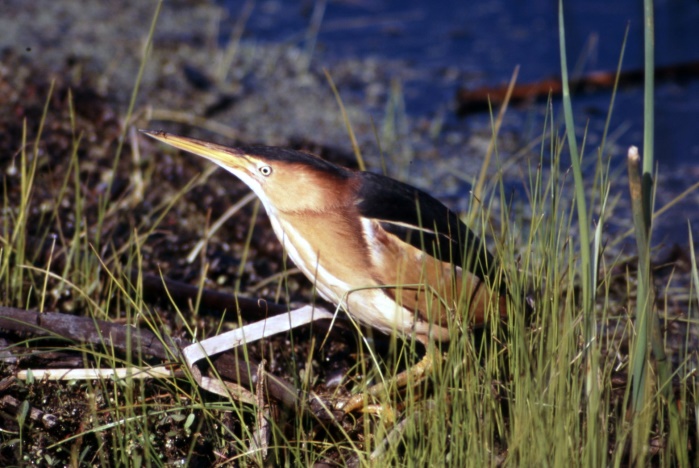
The first red-headed woodpecker I’ve encountered here since 1998 lands directly behind a second high in a granddaddy oak. Each leans horizontally along the limb, pointing its bill downriver. The first scoots low along the other’s back, and their scarlet heads wag. White-and-black wings flutter, fluff, tilt, and minutes later one red-headed taps a maple snag beneath a hole, bowing partway in. The second pokes out its head, chortling, Quirr! Quarr! Quarr! The first hitches itself excitedly up to a broader hole, and a wood duck veers deftly through treetops, landing above the snag. She peers at the red-headed as it goes all the way in. The big-white “teardrops” around her eyes look gentle and pretty, but her brood may be in the hole, and wood ducks sometimes clasp and snap intruders’ necks.
I saw my first wood ducklings out of their nest cavities this spring on Friday. They swam through white water lilies, a bald eagle plunged at them, and their mother hen splashed and flapped and zigzagged, screaming Oo-eek! Oo-eek! The eagle rose with empty talons, scattering egrets and herons, dive-bombed by a redwing, and the hen cried on. But this hen merely settles her belly down on her branch and watches the red-headed woodpecker silently as it flies to its courtship limb again, re-joining its mate while two more red-headeds quarr from opposite directions.
Red-headed populations have declined by half since 1966, perhaps due to possible causes listed in last week’s post. They appear amid Aghaming’s oldest oaks and cottonwoods, where cerulean warblers bred from at least 1993-2000. Acorn-abundance sometimes determines the presence of red-headeds, who hammer them so tightly into storage-cracks blue jays and other animals can’t pry them out.
Least bitterns call from Osprey Marsh this morning, also from other cattails, bulrush and arrowheads just south of Prothonotary Trail. Tut-tut-tut, tut-tut-tut, tut-tut-tut. USFWS considers the species a conservation priority, rare and declining. Least bitterns lost nearly five million acres of inland-wetland habitat in North America between the mid-1950s and mid-1970s.
You can wait hours to see a least bittern standing secretly in a dense marsh, pointing or bending its bill like a reed—or stalking, grasping plant-stalks with long toes and curved claws, using reeds as stepping stones above watery marsh-muck. The species builds the foundation of its nest with spokes of sticks, pulls down and crimps surrounding stalks, adds a roof-canopy of vegetation and pokes holes in the nest-floor that drain feces. It also builds platforms from which to spear frogs, small fish and other prey.
Another USFWS conservation priority, a state-threatened species in Wisconsin, shrieks invisibly atop the forest. KEE-AHH! KEE-AHH! KEE-AHH! A great-horned owl hunches in a high-cottonwood limb, glowers, pinches its head-tufts inwardly, irritably, and the red-shouldered hawk continues to unleash its scream-lashing from a taller cottonwood. It glides a tight-haughty circle, showing glimpses of under-wings stiffly open, richly rufous, white-barred through gaps in the woods. The owl flushes. The KEE-AHHs follow.
The red-shouldered seems to shriek halfway to Hannibal, halfway to Itasca. I imagine it uses its sheer, vexatious loudness to scream the species’ habitat back into being–mature floodplain forest 90% gone from the Midwest. In reality, the cries probably serve another motive. Red-shouldered young hatch here about mid-May and perch flightless in treetops during early June, and the hawk keeps the fledgling-eating owl away from them.
Now caws and carg-arg-arghs pitch harshly in treetops, eager-sounding. Six, eight, twelve crows drop through a maple crown, and a barred owl fledgling waddles on a limb, tucking a face with gray-fuzzy eye-discs and a yellow-hooked beak against the trunk. A crow dives against its downy-mottled wings. The fledgling swivels its head, blinking black-gawking eyes, and the crow-din rises, and an adult owl soars through trees, turning away from the fledgling, but no crows give chase.
HOO-HOO-HOO-TO-HAW-HAW-AW-AW! The adult shouts gruffly, returning, swooping broad-winged at crows. Some crows quiet. Others vanish, and minutes later the fledgling methodically climbs the maple, still hugging the trunk, clawing its way up with its feet, and then it perches on a limb, preening its fluffy shoulders while the adult watches from a walnut-top.
Like the red-shouldered hawk, the barred owl prefers large, unbroken forests such as occur at Aghaming and throughout the Upper Miss. It finds its nest cavities in old trees and probably chooses dense forest-canopies for protection from mobbing.
Meanwhile a ruby-throated hummingbird hovers above a nest the size of a ping-pong ball cut in half, found in a narrow-dangling limb above a slough. Dull-green lichen splatters the nest, a cottonwood seed blows from it, and she zooms after it, returns, needles it inside the rim.
A tongue white and sticky-looking with spider-web silk shoots out her bill. She fusses hyperactively, swiping her bill beneath the limb. She pushes her belly down, forming the cup, and since the male has the blazing throat and hers is pale, her bill blends with the skin-tight gray of the young maple branch, looking like a twig-tip.
One scientist found ruby-throat breeding may coincide with columbine blooms, but columbine has gone to seed here. Blue flag, Canada anemone, beardtongue and beggarticks blossoms near the nest.
Though we associate the ruby-throat with flower gardens, it may be another bird dependent on woods. It breeds only in the range of eastern deciduous and mixed forests.
SOURCES
Crocoll, S.T. 1994. Red-shouldered Hawk (Buteo lineatus). The Birds of North America Online. Ithaca: Cornell Laboratory of Ornithology; Retrieved from The Birds of North America Online database.
Gibbs, J.P., F.A. Reid, and S.M. Melvin. 1992. Least Bittern. The Birds of North America, No. 17. (A. Poole, P. Stettenheim, and F. Gill, eds.) The Birds of North America, Inc. Philadelphia PA. The Academy of Natural Sciences, Philadelphia PA, and the American Ornithologists’ Union, Washington, D.C.
Mazur, K.M., and P.C. James. 2000. Barred Owl (Strix varia). In The Birds of North America, No. 508 (A. Poole and F. Gill, eds.). The Birds of North America, Inc., Philadelphia, PA.
Robinson, T.R., R.R. Sargent, and M.B. Sargent. 1996. Ruby-throated Hummingbird (Archilochus colubris). In The Birds of North America, No. 204 (A. Poole and F. Gill, eds.). The Birds of North America, Inc., Philadelphia, PA.
Smith, K.G., J.H. Widgott, and P.C. Rodenwald. 2000. Red-headed Woodpecker (Melanerpes erthytrocephalus.) In The Birds of North America, No. 518 (A. Poole and F. Gill, eds.). The Birds of North America, Inc., Philadelphia, PA.
U.S. Fish & Wildlife Service. January 2002. Fish and Wildlife Resource Conservation Priorities. Region 3. Version 2.0.
SINGING, LEARNING, CHARMING, 6-10-2007
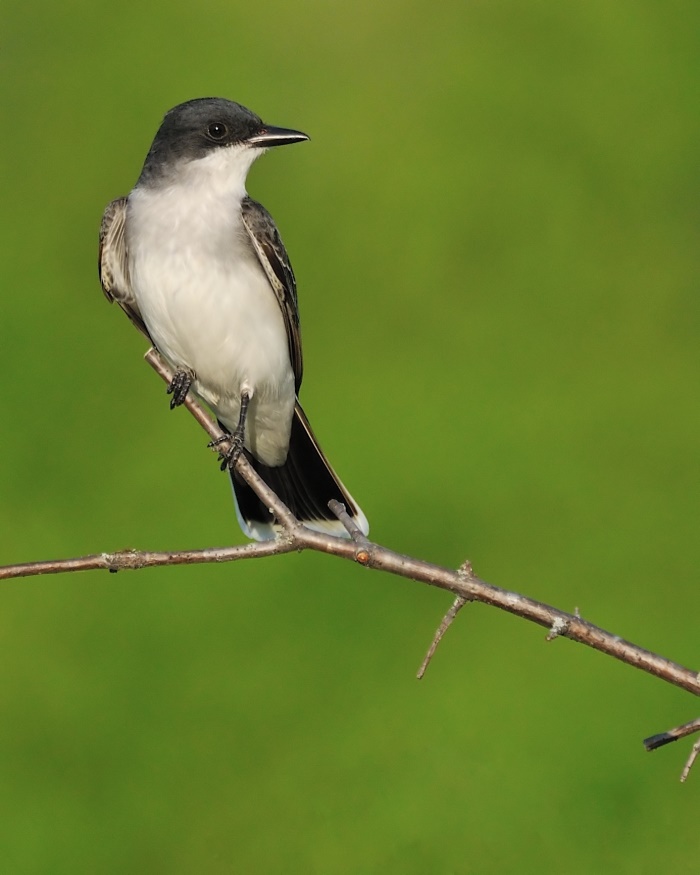
A Canada warbler singing on June eighth? More than 80 miles south of the nearest nest record in Wisconsin? Chip-chupety-swee-ditchety! He advertised for a female all morning, ending his song with itchity like a common yellowthroat, flashing his black necklace above ferns, fallen logs, upturned tree roots and mossy rocks on swampy-forested banks—all suitable nest cover. An Eastern kingbird fluttered shallow wingbeats in midair, bumping bills with another, hovering slowly down to a dike, rasping, Kitterkitterkitter! She picked up a stick and tossed her head high, shaking her prize up, down, sideways. She dropped it, seized it again, repeated her routine, then flew followed by the other. She performed stick-behavior I did not find in science, and then a yellowthroat raised his black mask, singing phrases I haven’t heard during 30 years of listening. We-chew we-chew we-chew a-chew! Chew-chew-chweet-chweet!
Though common yellowthroats usually sing witchity-witchity-witchity, the species has exhibited vocal learning in captivity and has been observed singing a chestnut-sided warbler song in the wild. Males sing “perch” songs individually recognizable by human ear, attracting females, defending territories. This morning the yellowthroat sings continually from a 20-foot maple beside a marsh, suddenly warbling as richly-toned as a Swainson’s warbler. He rises out of buttonbush, and so does the kingbird, fluttering up with an 18-inch branch more than double her height.
I call her “she” because females build the species’ nests, and she places her branch high atop a power-transmission pole, letting all its sloppy side-twigs dangle down a porcelain insulator. She brings and places a 12-inch twig on a metal plate between crossbars, flutters above a male on a wire, calls, Kt’zee! Kt’zee! He does not stir.
She brings an eight-inch twig, and he flutter-hovers down to the plate, lowering himself on her twig-pile. The plate conceals their wings, but their white-banded tails pump together, and then she takes a twig to a tree beside the power company’s right-of-way, perhaps to a nest-site safer from wind, rain or stray voltage.
He stays on the wire again, perching with a handsome-dark face and white breast identical to hers, and she flutter-hovers a circle above him, holding another stick, and then they fly across a marsh to the dike where the stick routine occurred Friday.
Female kingbirds may build several potential nests before a final choice. She must also overcome aggressive territorial chases by the male before mating, perhaps charming him with stick displays, and then she drives him away while she incubates, but she allows him to feed nestlings and carry off fecal sacs.
As fickle as human couples? I walk down Prothonotary Trail to the Canada warbler spot, failing to encounter the species for the second straight day. The Canada has declined by 40% since 1966, and I’m disappointed I can’t add it to Aghaming’s breeding list. Nonetheless avian reproduction here seems layered with infinite activities and intricacies, endless questions and adaptations, not contradictions.
Eastern kingbirds hawk insects from wires but follow the ripening of fruit through Central America on their way here, dump eggs like cowbirds in one another’s nests, also allow third adults to help at nests—probably first-year bachelors.
Female yellow-headed blackbirds emerge from cattails, suggesting males singing kuk-koh-koh-koh-waaaaaa and displaying “rowing” wing-beats do not merely exist as floaters here, waiting for a harem next year. Two American eagles perch above a nest empty of eaglets, squealing at intruders as if guarding the site to try again next February.
The osprey of Osprey Marsh hunkers low in her power-pole nest box, apparently ready to guard hatchlings any day. A green heron grunts skee-ow! It flushes, and the sun turns its wings as blue as enamel, as glaring and glossy as a desert sky. It tiptoes with blazing-orange feet, leans forward with a bittern-like neck and drops bait, maybe a feather or worm or mayfly, atop a slough for a fish.
One prothonotary warbler sits on five eggs in an open-topped stump. Another has a cowbird’s tail sticking out a nest-hole in the side of a thin-dead branch wedged straight in mud. Another peers from a hole in a broken bridge-rail. Another drops from a 25-foot trunk and immediately slaps and slurps a worm in a knee-high bush. Another pops in and out a chest-high stump as if just starting to choose a cavity.
A red-bellied woodpecker forages low on a trunk, and a great crested flycatcher dives down. Churrs! Chucks! Rurrs! Whit-weeps! The two dart and flap through leaves, and the flycatcher flies high to its hole, leaning halfway into cavity-shadow, twisting its sun-yellow breast, glaring over its shoulder, raising its smoky-gray crest. Its look says it clearly intends to remain in possession next week too, and woodpeckers are not allowed to excavate or eat anything inside.
SOURCES
Conway, C.J. 1999. Canada Warbler (Wilsonia Canadensis). In The Birds of North America, No. 421 (A. Poole and F. Gill, eds.). The Birds of North America, Inc., Philadelphia, PA.
Davis, W.E., Jr., and J.A. Kushlan. 1994. Green Heron (Butorides virescens). In The Birds of North America, No. 129 (A. Poole and F. Gill, eds.) Philadelphia: The Academy of Natural Sciences. Washington D.C.: The American Ornithologists’ Union.
http://www.birds.cornell.edu/bfl/speciesaccts/canwar.html.
Murphy, M.T. 1996. Eastern Kingbird (Tyrannus tyrannus). In The Birds of North America, No. 253 (A. Poole and F. Gill, eds.) The Academy of Natural Sciences, Philadelpha, PA. The American Ornithologists’ Union, Washington D.C.
Stokes, Donald W. 1979. A Guide to Bird Behavior, Volume 1. Little, Brown and Company. Boston. Tortonto.
AN EXCESS DURING SOLSTICE WEEK, 6-19-2011
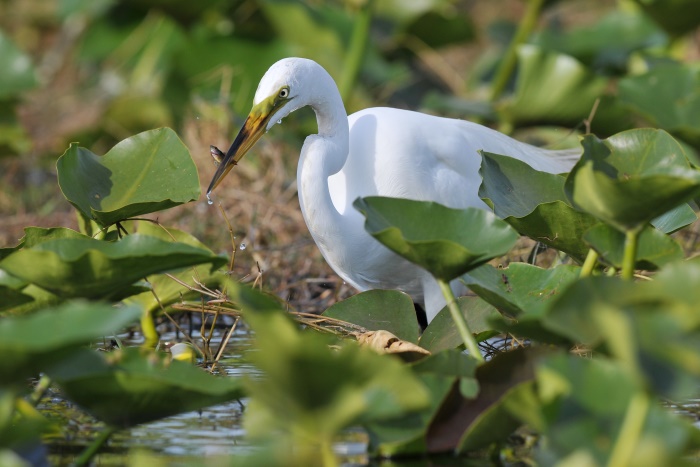
As the sun finishes its seasonal circle above the Mississippi, nearing the northernmost point on the celestial equator, rising behind the most-upriver bluff this year, dawn glows indigo, and 85 great egrets drop through a heat-fog the same hazy-gray as herons’ wings. The egrets growl like soft-toned dinosaurs above Osprey Marsh. The wind gusts, and they flutter like giant-white butterflies, dipping like swallows above waves, scooping fish with dangling bills.
The first red-headed woodpeckers here since 1998 quarr, kritt and drum in alarm from the bottomland woods across a slough. They may not know it, but they suffer an excess of European culture. A pair flies to a courtship limb where reverse-mounting occurred last Sunday, a sign of a deepening pair bond. The two woodpeckers swing together in perfect ritual, but now the female flies off, leaving the male bobbing by himself.
A European starling—a species released in New York City in 1890 in an effort to introduce all birds mentioned in Shakespeare into America—whistles a shrill note from the hole the woodpeckers have used for two weeks. The starling flies out, and a red-headed chortles and swoops down, pecking, and the starling slips back into the nest-cavity, parts its bill, seems to hiss. More than 200 million starlings now exist in North America. The red-headed has declined by half since 1966, 4.6% per year since 1980, is one of eight woodpeckers on Audubon’s national watch list.
Starlings can evict at least six other cavity nesters at Aghaming—wood ducks, northern flickers, red-bellied woodpeckers, tree swallows, great crested flycatchers, eastern bluebirds. Starlings were once considered a primary cause of the red-headed’s decline; however they begin nesting about two months earlier, and their impact remains mostly unstudied. Here, a starling appears to start a second brood along with thousands of others in town, while two or three pairs of red-headeds make the first attempts at Aghaming-breeding I’ve witnessed in nine-years.
Summer Solstice Week also sings the news of “neotrops” who, around the time of Fall Equinox, will migrate down the Mississippi Flyway and other routes to feed on hatching insects during lengthening days in the Southern Hemisphere.
An American redstart tsee-tsee-tsee-tsees. He flashes tiny, black, orange, low in an oak, high in a walnut. He flushes bugs, snaps them up, and I can’t figure his darts and dives, his song-bursts. He may change his perch 30 times per minute and sing five different song-types. When his mate starts to incubate eggs, he may fly out of earshot and sing a new song, advertising for a second mate.
A male redstart at one study site guarded three nests and guarded four territories simultaneously. This one may be foraging to provide 50% of the food trips to a nest. He may be feeding nestlings mostly sired by other males, or he may belong to a local population singing more than 100 different song-types.
Peee-ah-weeeee! The Eastern wood peewee sleepily slurs his name, tossing his head slowly sideways, showing a breast as grungy-gray as the clouds of mosquitoes he hunts, his wings pale and olive like the undersides of silver maple leaves. The species declined 35.6% 1966-1993 and continues to drop 1.78% per year. Its nest may be 65-feet up a tree and is so infrequently seen details of its construction remain unknown.
A yellow-billed cuckoo peers down from a treetop, a species that declined 95% in Wisconsin 1966-1996 and continues to drop 2.5% in the upper Midwest. It ticks out its knocker call, kow-kow-kow-kow-kow-kow, and its long-drooping wings, yellow-washed throat and slender-white tail-patches vibrate in time.
The knocker call may coordinate nest-tending activities, and now a cuckoo drops from a grapevine mass. It gapes with its long-hooked beak, following my movements with red-rimmed gazes. Another shuffles behind my neck, passing between damp honeysuckle shrubs the moment after I do. The cuckoo’s longest song, slow-wooden kas, kows and kowlps, knock through trees as if the floodplain could hardly hold more this year.
A yellow-throated vireo also pulses its throat as it sings. A warbling vireo buzzes testily and winds up its nasal wheeze before scampering down a dangling branch, carrying a moth to her nest. Parent-orioles pipe, ak-ak and rattle-scold their way down tree-crowns while fledglings chee-chee-chee, begging behind foliage.
A yellow warbler tswee-tswee-tswees beside the marsh while an osprey plunges in, scattering the butterfly-egrets, flapping and bathing, tossing humid-glistening water behinds its head. Least bitterns call soft coos and tut-tut-tuts, but Summer Solstice also comes with silences, signs of absence.
American bitterns do not “thunder-pump” or call pump-er-lunk or dunk-a-doo at Osprey Marsh. The twee-twee-tweez of cerulean warblers does not whisper down from granddaddy cottonwoods or oaks. The cu-cu-cu-cus of the black-billed cuckoo have not been heard. As spring 2007 passes, not all species regenerate in available habitat to grow from summer resources.
SOURCES
Cable, P.R. 1993. European Starling (Sturnus vulgaris). ). In The Birds of North America, No. 48 (A. Poole and F. Gill, eds.) Philadelphia: The Academy of Natural Sciences. Washington D.C.: The American Ornithologists’ Union.
Hughes, J.M. 1999. Yellow-billed Cuckoo (Coccyzus americanus). In The Birds of North America, No. 418 (A Poole and F. Gill, eds.) The Birds of North America, Inc., Philadelphia, PA.
McCarty, J.P. 1996. Eastern Wood Peewee (Cantopus virens). ). In The Birds of North America, No. 245 (A Poole and F. Gill, eds.) The Birds of North America, Inc., Philadelphia, PA.
Sauer, J.R., J.E. Hines, and J. Fallon. 2005. The North American Breeding Bird Survey, Results and Analysis, 1996-2005. Version 6.2.2006. USGS. Patuxent Wildlife Research Center. Laurel MD.
Sherry, T.W., and R.T. Holmes. 1997. American Redstart. (Setophaga ruticilla). In The Birds of North America, No. 277 (A. Poole and F. Gill, eds.) Philadelphia: The Academy of Natural Sciences. Washington D.C.: The American Ornithologists’ Union.
Smith, K.G., J.H. Widgott, and P.C. Rodenwald. 2000. Red-headed Woodpecker (Melanerpes erthytrocephalus.) In The Birds of North America, No. 518 (A. Poole and F. Gill, eds.). The Birds of North America, Inc., Philadelphia, PA.
NO QUIRR, NO QUEAK, YET SAPSUCKERS SQUEAK, 6-26-2007
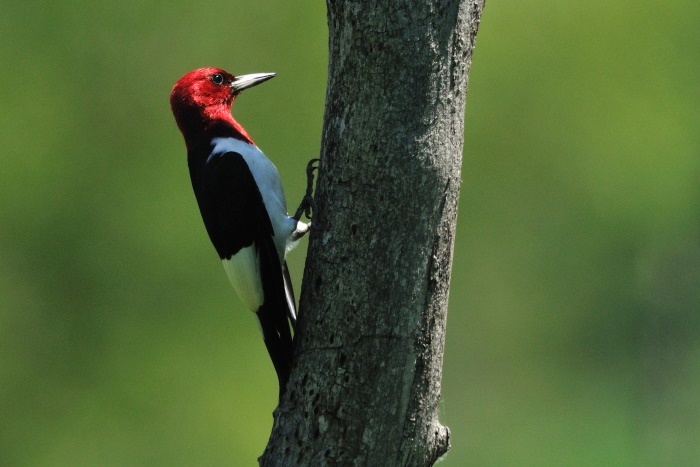
One minute, the blue-black Mississippi cast a glossy dawn-reflection of the tall-dark woods that have been housing the first red-headed woodpeckers I’ve encountered at Aghaming since 1998. The next moment, a breeze smelling of backwaters fermenting, of humid-black mud curdling in sloughs, wafted upriver, and fog hid the channel and bluffs. It hung green between trees in the woods as if it were sucking up and oozing the color from the chin-high poison ivy all around the nest-hole tree. I waited. No red-headeds called or appeared 5:20-6:00 A.M., nor 6:50-7:10. Sleeping in? Hidden in tree-crowns 70-feet high, dense-dark with foliage? Evicted? Depredated? No red-headeds came to the hole or nearby woods 7:00-11:30 the next morning. No quirr. No queak.
A pair of red-headeds mounted, called from the hole, were watched by a wood duck hen June second. A pair reverse-mounted and popped in and out of the hole continually the 10th. A pair scolded a starling in the hole, and a wood duck hen flew through the treetop the 17th. No bird of any kind occurred at the hole the 24th or 25th.
Red-headed woodpeckers declined 50% 1966-2000 and continue to decline 4.5% per year in the Upper Midwest. Have they disappeared suddenly from Aghaming this year? Did their breeding attempt fail?
Initially, the species called from multiple directions simultaneously, indicating two or three possible territories. Red-headeds may have appeared undetected in May, may be dispersing already with young from successful cavities, but I saw no food trips to the hole. Both sexes incubate, so perhaps one was inside the cavity on eggs yesterday. And the other?
This morning I tuck myself against buttonbush one-half mile from the red-headeds’ hole, checking a warbling vireo nest in an overhanging maple between forest and marsh. Tsew! Tsew! Tsew! Yellow-bellied sapsucker nestlings cry from a hole 25-feet up a black willow, adding a squeak to the juh-juh-juh adults uttered in April as they flapped frantically around trunks, pair-bonding. Now a mama sapsucker lands by the hole, and tsew-tswe-tsews get louder, sweeter in tone, faster. Lawrence Kilham called the nestlings’ message “hurry, hurry, hurry,” noting that feeding had better happen fast, since the sounds might draw predators as well as birders.
As the sapsucker tips in the hole, a yellow warbler fills a bill with bugs from leaves right beside it, gathering food for nestlings. A brownish-bluish bunting hops and perches to a branch-edge, its breast mottled gray and blue, likely the young of the adult Indigo bunting singing atop a nearby maple.
Fledglings of two species of special concern in Wisconsin flutter suddenly in a walnut tree. A yellow-billed cuckoo pumps an undeveloped tail, shows fuzz around its hooked beak, slips as furtively as an adult cuckoo into foliage. A prothonotary warbler booms peet!tsweet!twseet!tsweet! The bright-gold male bends with mosquitoes crosswise in his bill, and a fluffy head arches up, the fledgling’s breast splotched gray and Creamsicle-orange.
Rattles, churs, hisses, buzzes come harshly from the buttonbush. A house wren points its flesh-colored bill at me, tosses up its tail, braces its wings aggressively. Another gushes and intensifies its bubbling song. A third quivers its wings, gapes, begs.
The buttonbush moves—a redstart fledgling darts and forages, its tail-patches and shoulders yellow like an adult female’s, its olive wings splotched sloppily white, its head-crown still looking as soft and downy as a puffball.
Switch grass waves beside a game trail. Chee-chee-chee! Chee-chee-chee! A Baltimore oriole feeds a stubby-winged, short-tailed young and flies up to two more fledglings flapping awkwardly in a cottonwood, looking very prone to hungry crows, hawks or the barred owl perched 30 yards away.
Four more oriole fledglings fly full-winged across Prothonotary Trail and down to the backwater I call Cuckoo Slough. They perch on bare-branches rising above the slough, begging. They splash down into fermenting bubbles, mucky-green algae blooms, find some clear water, toss it over their backs. As their mother descends a grapevine, an Eastern wood peewee fledgling turns away, hiding. The mama oriole lowers her bill with a wad of moths. The fledglings splash on. Bathing suddenly looks too good to stop to eat.
The warbling vireo nest? The species sang here May fourth, arriving from as far south as El Salvador, rarely Nicaragua. A pair gathered bark strips from a rotten trunk the 19th, brought grapevine shreds and cottonwood seeds to the nest the 25th. A bird sat low on the nest June eighth. It brought worms and moths June 23, and though warbling vireos are the smallest-known species to evict brown-headed cowbird eggs from a nest, a cowbird chick begged, and I saw no other nestlings.
Warbling vireos do not attempt second broods in the eastern U.S. The pair must shed old feathers and grow new. It will leave the nest-area as early as mid-August. The birds must survive another winter and next year’s spring migration before trying again.
SOURCES
Gardali, T., and G. Ballard. 2000. Warbling Vireo (Vireo gilvus). In The Birds of North America, No. 551 (A. Poole and F. Gill, eds.). The Birds of North America, Inc., Philadelphia, PA.
Kilham, Lawrence. 1983. Woodpeckers of Eastern North America. Dover Publications, Inc. New York.
Sauer, J.R., J.E. Hines, and J. Fallon. 2005. The North American Breeding Bird Survey, Results and Analysis, 1996-2005. Version 6.2.2006. USGS. Patuxent Wildlife Research Center. Laurel MD.
Smith, K.G., J.H. Widgott, and P.C. Rodenwald. 2000. Red-headed Woodpecker (Melanerpes erthytrocephalus.) In The Birds of North America, No. 518 (A. Poole and F. Gill, eds.). The Birds of North America, Inc., Philadelphia, PA.
www.dnr.state.us/org/land/er/working_list/taxalists/birds.htm. (The Natural Heritage Inventory Working List: Rare Birds).
WARBLER, COWBIRD, PREDATORS, 7-04-2007
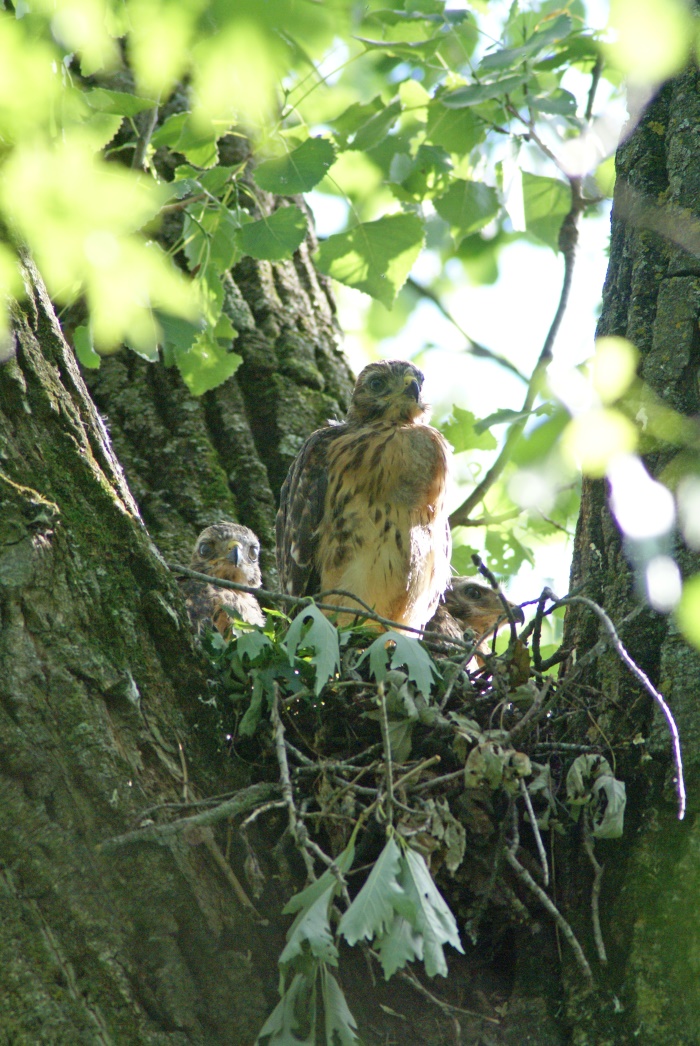
The towering double-trunk cottonwood seems a likely place to take a last-ditch listen for North America’s most steeply declining warbler, the cerulean. I pause during this field season’s final visit. A prothonotary warbler flashes in foliage instead, shaking a mulberry too big-looking for the tiny-gold bird to swallow. He tightens his bill and shuffles the berry. He drops it, dives down, darts up, and a brown-headed cowbird flaps its fledgling-wings, begging. The prothonotary feeds it, flits on, gleans a bug from a leaf and feeds a second cowbird fledgling.
Male prothonotaries weigh about 15 grams. Adult cowbirds may grow to nearly 50 grams and can deposit 30-40 eggs in other species’ nests per season. This prothonotary has evidently failed to reproduce this year. He will likely lose weight, raising the cowbirds. He may die from exhaustion.
The scene reflects changes in the Mississippi, the surrounding landscape and bird populations since European settlement. “Almost everything humans do in manipulating our environment is beneficial to cowbirds,” writes Lisa Petit, Smithsonian Migratory Bird Center. Before the 1800s brown-headed cowbirds bred only in habitat now virtually gone, short-grass prairies of the Midwest. They now feed in grain and livestock areas, pastures, farm fields, grassy areas, even urban birdfeeders coast-to-coast.
Throughout their range they find host species for their eggs in smaller forests that provide fewer acres for hosts to hide nests. Here, they parasitize tropical migrants and other species in floodplain forest 90% diminished in the Midwest, partly because the Mississippi and other channelized rivers inhibit sapling diversity and density and forest regeneration.
Smaller forests also provide easier access for nest predators such as crows, raccoons, opossums and common grackles. This morning grackle fledglings screech by the 100s, begging at nearby Osprey Marsh with 100s of European starling fledglings, an exotic species capable of evicting at least seven of the 20 bird species that depend upon holes in trees and stumps for nest-sites here.
Sunday, two great crested flycatchers perched outside a nest-hole used by red-headed woodpeckers June 2-17, amid swamp white oaks older than the river’s locks and dams. One great crested peered inside, perhaps investigating the cavity for a second brood. The red-headeds had mated on a nearby limb, had called from the hole. They disappeared in the middle of reproductive efforts.
Red-headeds have declined more than 50% since 1966, probably due to multiple causes. Two obvious hazards exist less than 150 yards from the oaks: creosote in abandoned railroad ties, also a highway with banks of insect-prey and traffic unforgiving to the species’ low take-offs.
Cerulean warblers sang amid the same oaks and tall cottonwoods during my 1998 breeding bird study, also during June 1993-1997. They winter in South American forests rapidly disappearing. They may lack stopover habitats necessary to cross the Gulf of Mexico.
Ceruleans once bred especially abundantly in old-growth forests of the Mississippi Alluvial Valley (the river valley south of the Ohio Valley). These forests are gone. Before clearing, the Mississippi Alluvial Valley may also have provided crucial habitat for the Bachman’s warbler, now probably extinct. The alluvial valley may still support 20% of the entire breeding population of the prothonotary warbler, a floodplain-forest specialist with only ten percent of its habitat remaining.
Though Aghaming apparently supported no ceruleans this year, prothonotaries arrived April 26 and established numerous nest-holes beside backwaters.
One male first sang by an open-topped stump near the oaks May 6. A female carried in wads of moss wider than her face May 26. A mirror showed one egg June 2 and five June 10, none dotted brown or oversized like cowbird eggs.
A female snuck into the stump with worms in her bill, zigzagging up a crack June 17. June 25 found the nest empty, perfectly in tact, not pulled apart as if by a raccoon, or littered by eggshells as if poked by a wren, though opossum-tracks crossed mine near the stump.
A fledgling pecked upturned roots July 1, a fluffy gray streak smudging its golden breast. It raised its head abruptly, and an adult female fluttered down immediately, and their bills met. An adult male fed a second fledgling in buttonbush and followed a third in nettles.
A red-shouldered hawk apparently guarded fledglings also, chasing a young Cooper’s hawk from an island. Two young belted kingfishers dove without success for prey, and two adults chased them back to fishing perches as if to insist they keep trying.
The week the federal government announced it will remove the bald eagle from its endangered species list, two eagle fledglings perched beside a nest established last year, the first at Aghaming in my 30 years of birding here.
Only 417 pairs of bald eagles existed in the Lower 48 in 1963. The ban on DDT, habitat protection and other policies enacted by humankind helped the species to recover to 11,040 pairs today.
The cerulean, prothonotary and Bachman’s warblers tell us we must also keep trying, solve bird-questions scientifically and let fly our own spirited solutions, finding ways to allow birds using two continents, not just one, to sustain themselves.
SOURCES
Hamel, P.B. 1995. Bachman’s Warbler (Vermivora bachmani). In The Birds of North America, No. 150 (A. Poole and F. Gill, eds.). The Academy of Natural Sciences, Philadelphia PA, and the American Ornithologists’ Union, Washington, D.C.
Hamel, P.B. 2000. Cerulean Warbler (Dendroica cerulean). In The Birds of North America, No. 511 (A. Poole and F. Gill, eds.). The Birds of North America, Inc., Philadelphia, PA.
http://audubon2.org/webapp/watchlist/viewSpecies.jsp?id+176.
Lowther, P.E. 1993. Brown-headed cowbird (Molothrus ater). In The Birds of North America, No. 47 (A. Poole and F. Gill, Eds.) Philadelphia: The Academy of Natural Sciences; Washington, D.C.: The American Ornithologists’ Union.
Petit, Lisa. Brown-headed Cowbirds: From Buffalo Birds to Modern Scourge. Fact sheet, Smithsonian Migratory Bird Center.
Petit, L.J. 1999. Prothonotary Warbler (Protonotaria citrea). In The Birds of North America, No. 408 (A. Poole and F. Gill, eds.). The Birds of North America, Inc., Philadelphia, PA.
LAST LOOK AT UPPER & LOWER MISS BIRDS, 7-04-2007
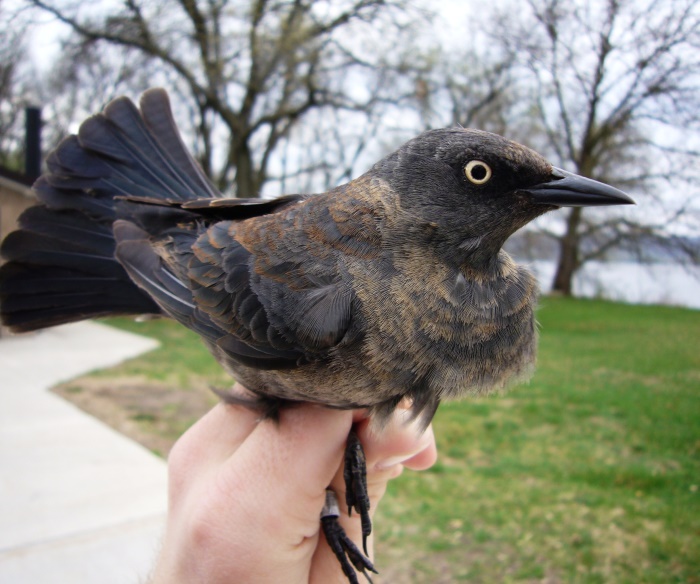
I took a last look into Aghaming Park and Preserve after birding it dawn-to-noon four morning per week since February. A prothonotary warbler fluttered luminously yellow, darting for bugs, feeding fledglings, and a great crested flycatcher rasped, dive-bombing a yellow-bellied sapsucker from a tree-hole. An American redstart slapped a caterpillar against a branch until gut-juices splashed. A yellow-billed cuckoo pumped its tail and wings in time to its knocker-call. An Eastern wood peewee slurred pee-ah-wee sleepily and abruptly chased another bird from a hunting perch. All these birds winter in mature forests disappearing from Central and South America. I had begun my five-month immersion in their breeding habitat, obsessing on their conservation needs on the Upper Miss. I ended intrigued by the Lower Miss and a warbler never known to range north of the Ohio River, the Bachman’s.
Aghaming stands amid the Upper Miss Refuge, the largest reserves of bottomland forest in the Upper Midwest, woods about 90% gone from the region. However, woods once grew nearly everywhere on the Lower Miss too, covering 95% of the river valley south of the Ohio. During the early 1900s Bachman’s warblers bred abundantly in interminable shrubs, palmetto and cane that escaped all but the highest floods, as far as scientists know. Loggers, railroads and farmers cleared the driest ground first, and virtually no habitat remains for the Bachman’s warbler on the Mississippi. The species has not seen since 1961.
Cerulean warblers, which bred at Aghaming reliably 1993-1998, were among the most numerous warblers during the 1800s in Lower Miss woods, especially in old-growth. Now the old-growth is gone, and trees comprise less than one-fifth of the lower valley, and the cerulean declines so precipitously Wisconsin lists it as state-threatened. I found no cerulean breeding at Aghaming this year.
Maybe 100 pairs of prothonotary warblers bred here, perhaps more. The species arrived as silver maples leafed out, and river birch catkins emerged in late April. It carried mouthfuls of nest-moss and battled house wrens for nest-holes in stumps beside every slough. It sometimes fed brown-headed cowbirds fledglings instead of its own. The prothonotary nests only in floodplain forests. Only ten percent of its habitat remains. The Lower Miss may support 20% of the species’ entire population.
As sloughs thawed during late March, yet another species dependent upon Lower and Upper Miss stepped as nimbly as a tightrope artist along a wiry branch above water. The rusty blackbird tossed pieces of bark from floating logs and ate caddis fly larvae and other aquatic insects at Aghaming. It swarmed by the hundreds around flood pools and the forest floor. Audubon Society has called the species North America’s most sharply declining bird. It has declined 95% since 1966. It winters primarily in Lower Miss woods and breeds mostly north of the contiguous 48, where global warming and acid rain may be compromising aquatic insects and other nutritional resources in boreal wetlands.
Hooded mergansers and wood ducks also appeared late March, looking for nest-holes in older-larger trees, ultimately feeding young amid marshes crowded with bulrush, water lilies and arrowhead. The Lower Miss supports 61% of North America’s “hoodeds” during winter.
The river’s most swiftly declining duck, the lesser scaup, fed and rested here throughout April. Female scaups may die during spring migration, lay fewer eggs, or fail to breed due to low fat reserves. They may lack food resources, especially freshwater shrimp, at migratory stopover-sites. Pool 19 of the Upper Miss, Keokuk to Burlington, Iowa, provides the “bluebills” a reliable feeding place, but scientists wonder if too many use only one site.
Tundra swans hooting overhead in April, heading to arctic breeding grounds, raised a similar issue. Twenty percent of their eastern population now migrate on the Upper Miss. Forty thousand swans used pools seven and eight, Trempealeau to Genoa, Wisconsin, on a single day last fall, replenishing fat stores on only a small part of the river. Forty percent of North America’s waterfowl migrate on the Upper Miss, also concentrating in just a few pools.
During a waxing moon April 28 a whip-poor-will called, a species suffering local disappearances in many states. The next week Blackburnian, Cape May and blue-winged warblers fed around swamp white oak leaves the size of squirrels’ ears. Northern waterthrushes, veerys, ovenbirds, Swainson’s and Gray-cheeked thrushes picked around leaf-litter and slough-edges. Yellow warblers, yellowthroats, marsh wrens, even prothonotaries fed around cattails emerging.
Many of these birds flew across the Gulf of Mexico or through Central America and up the Lower Miss to the Upper. Now they utilized Aghaming habitats top-to-bottom. No Aghaming migrant rivals the blackpoll. The half-ounce bird may leave Bolivia or Brazil, fly to Hudson Bay, turn left and fly to Alaskan shores on the Bering Sea or Arctic Ocean. Blackpolls return across Canada to the Atlantic, turn south and fly up to 88 hours nonstop behind northwesterly winds to Bermuda, then behind southwesterlies to Venezuela or Guyana. They depend upon forests there to refuel before completing fall journeys of nearly 5,000 miles.
The state-threatened red-shouldered hawk at Aghaming lambasted owls and other raptors, screaming ear-splitting shrieks, evidently defending nestlings, chasing any would-be predator. I encountered the species only inside gates installed to block traffic, away from cars and boats with booming engines.
The week the federal government announced the removal of the bald eagle from its endangered species list, two eagle fledglings perched beside a nest established last year, the first I’ve seen at Aghaming in 30 years. A state-threatened osprey fanned her wings, shading hatchlings chirping in a nest box atop a power pole. State-endangered peregrine falcons nested at a nearby bluff. All have benefited from the 1972 ban on DDT.
More than 100 state-threatened great egrets hunted green frogs and other prey around sloughs and marshes, finding food for fledglings only a mile or two from nests, a crucial ingredient for a species that failed to breed in Minnesota as recently as 1980. Least bitterns and black terns used Aghaming’s marshes to breed, but I saw none of the declining American bittern or black-crowned heron or the state-threatened yellow-crowned night heron.
Two woodpeckers that have declined by more than 50% since 1966 used the granddaddy oaks and cottonwoods where I took my last look. Northern flickers mated as cottonwood buds emerged early April and called by nest-holes throughout Aghaming through June. Two red-headed woodpeckers pivoted sharply together and mated on a courtship limb near a nest-hole June 2. They vanished in the middle of reproductive efforts, along with at least two other calling red-headeds. Why? Did insect prey draw them to a bank on a nearby highway, where their low take-offs frequently lead to death? Did they get into creosote in abandoned railroad ties nearby? Did a nearby owl or Cooper’s hawk eat them? Did European starlings evict them from their hole? Did they encounter other toxins?
Humankind must answer many such questions and create and facilitate remedies if red-headed woodpeckers are to rebound like the river’s raptors. We must overcome problems as enormous as global climate change and navigational channels that supplant islands and trees if we are to prevent other species from joining the ranks of the Bachman’s warbler, and the passenger pigeon which once used the Upper and Lower Miss by the millions.
SOURCES
Anderson, Bob. Peregrine falcon information (update by email).
Anteau, M.J., Ph.D. Research Wildlife Biologist. Northern Prairie Wildlife Research Center. Jamestown N.D. (e-mail communication).
Anteau, M.J., Afton A.D. July 2004. Nutrient Reserves of Lesser Scaup (Aythya Affinis) During Spring Migration in the Mississippi Flyway: A Test of the Spring Condition Hypothesis. The Auk.
Hamel, P.B. 1995. Bachman’s Warbler (Vermivora bachmani). In The Birds of North America, No. 150 (A. Poole and F. Gill, eds.). The Academy of Natural Sciences, Philadelphia PA, and the American Ornithologists’ Union, Washington, D.C.
Hamel, P.B. 2000. Cerulean Warbler (Dendroica cerulean). In The Birds of North America, No. 511 (A. Poole and F. Gill, eds.). The Birds of North America, Inc., Philadelphia, PA.
http://audubon2.org/webapp/watchlist/viewSpecies.jsp?id+165
http://nationalzoo.si.edu/Conservationand Science/MigratoryBirds/Research/Rusty_Blackbird/decline.cfm
McCrimmon, D.A., Jr., J.C. Ogden, and G.T. Bancroft. 2001. In the Birds of North America, No. 570. (A. Poole and F. Gill, eds.) The Birds of North America, Inc. Philadelphia PA.
Sauer, J.R., J.E. Hines, and J. Fallon. 2005. The North American Breeding Bird Survey, Results and Analysis, 1996-2005. Version 6.2.2006. USGS. Patuxent Wildlife Research Center. Laurel MD.
Weidensaul, Scott. 2000. Living on the Wind: across the hemisphere with migratory birds. North Point Pres


